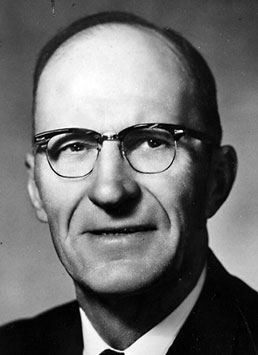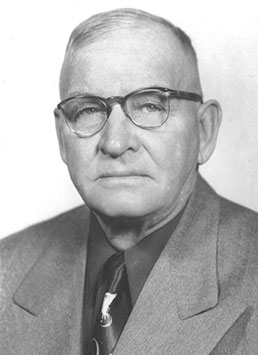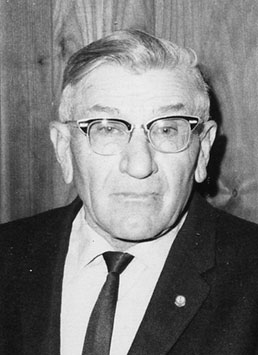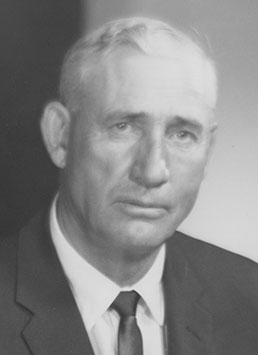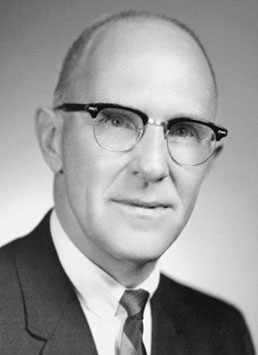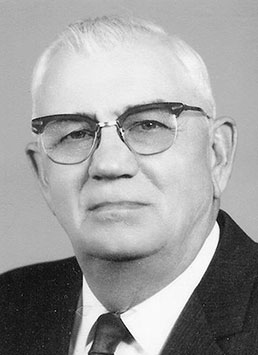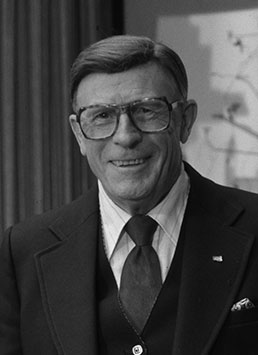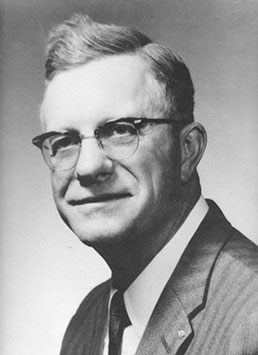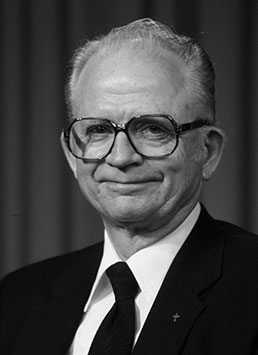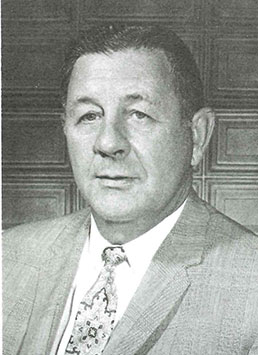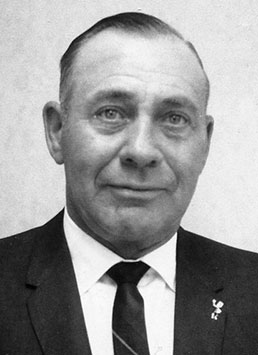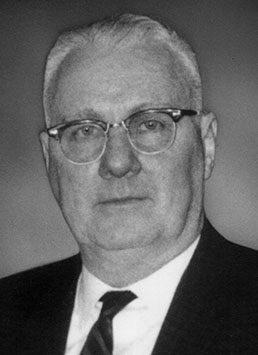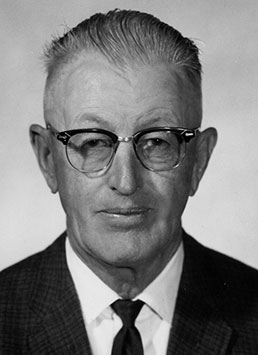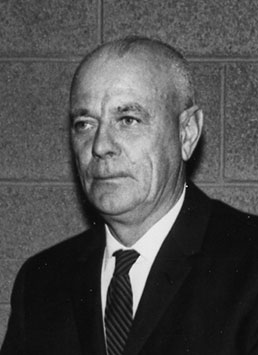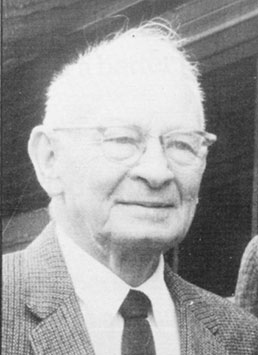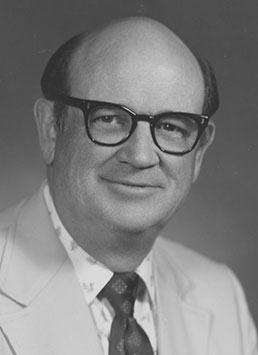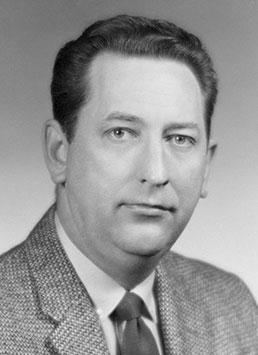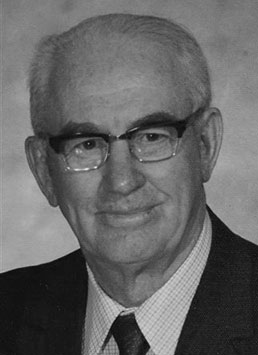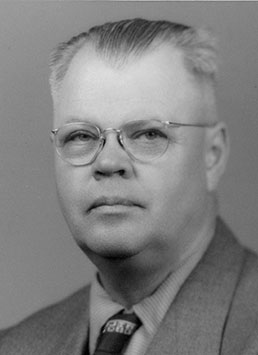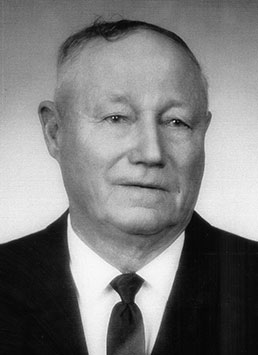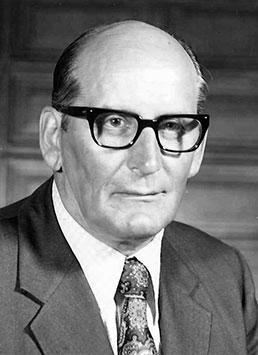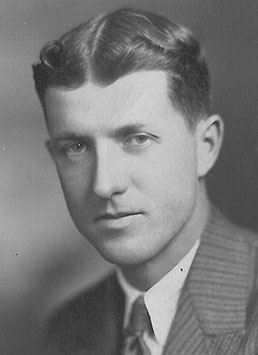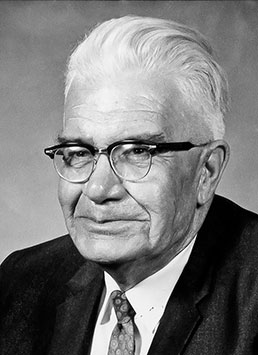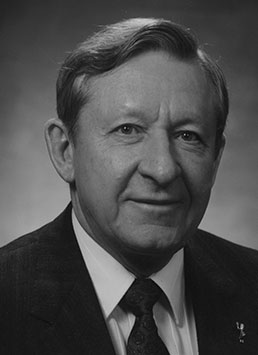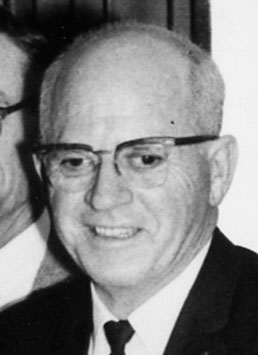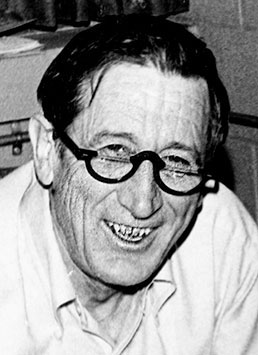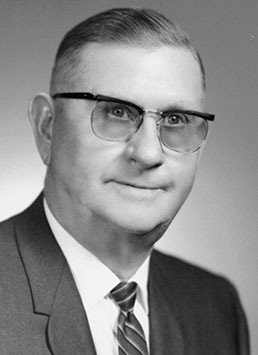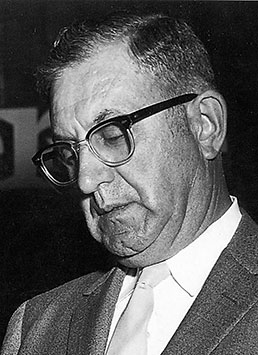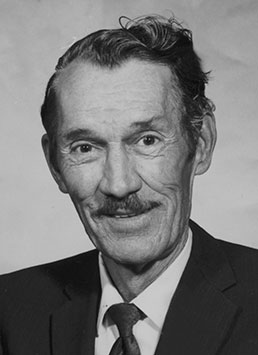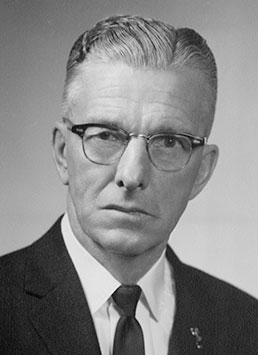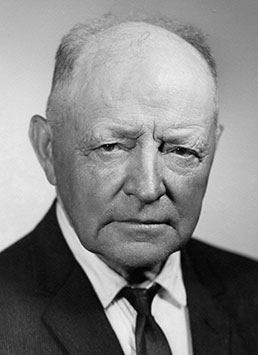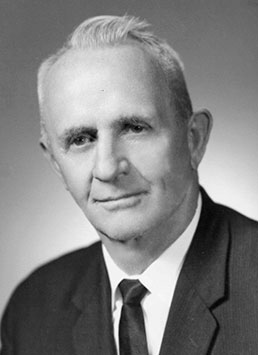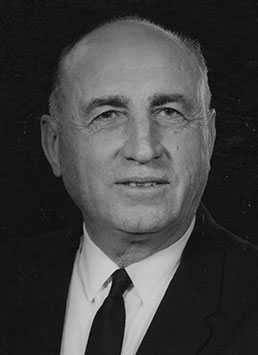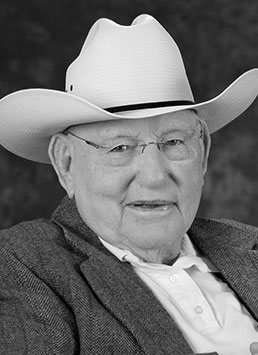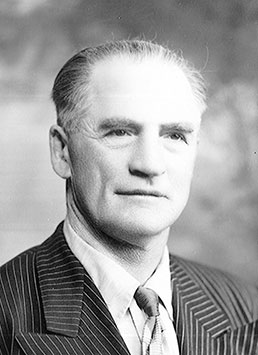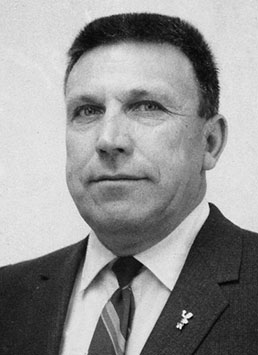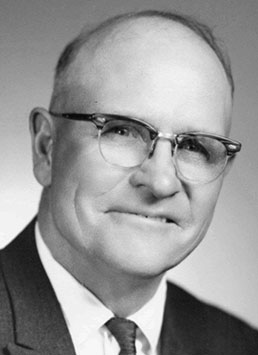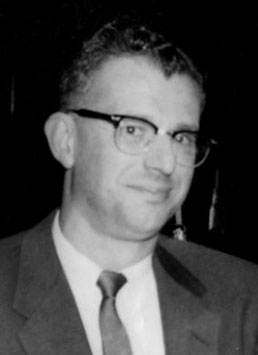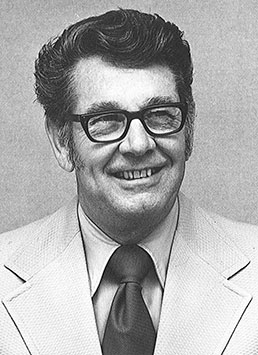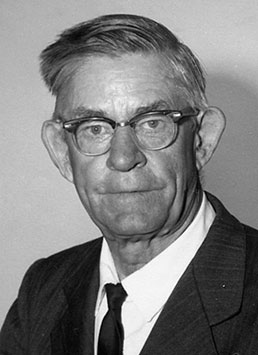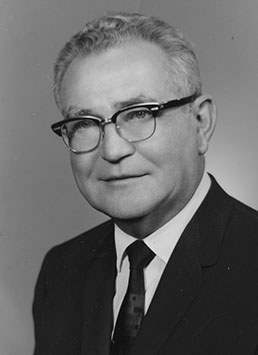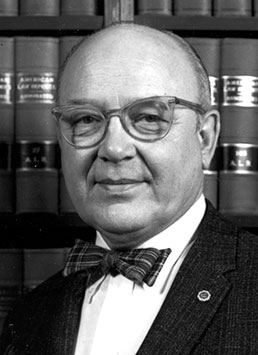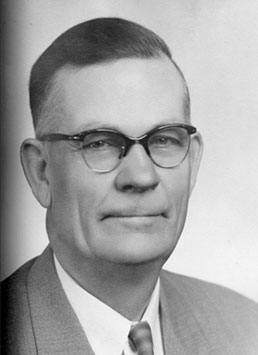Albert C. Hauffe
Albert Christopher Hauffe was a Chicagoan that got sidetracked in South Dakota on his way to make his fortune in Winnipeg. He was captivated by South Dakota farm life while visiting his father’s half brother, Otto, near Leola, SD. The friendly people and warm hospitality kept him there the rest of his life. He finally completed the trip to Winnipeg 32 years later for a vacation.
Born on July 28, 1897, Albert was the son of Paul and Anna (Baruth) Hauffe. Both of his parents had died by the time he was 14, so in 1914 at age 17, he decided to leave his extended family in Chicago.
While Albert liked farming, he decided to attend Boyles Business College in Omaha to pursue a curriculum for a railroad depot agent on the advice of Uncle Otto, who discouraged him from farming saying that it was a “tough” life. Upon finding out the curriculum had been terminated, he chose to study court reporting; it was something his father had studied in Germany. The courses consisted of shorthand, typing and grammar.
Albert married Otto’s daughter Alma in Omaha, NE, on Oct. 25, 1920. They began their life together on rented land with a half dozen cows and horses. The Hauffes reared three children, Paul, Harry and Ruth, on their 640-acre farm.
Albert became active in rural affairs because he felt his fate was tied up in the prosperity of the entire community. FEM Electric Association Inc., Ipswich, SD, was officially launched on Dec. 10, 1945. Hauffe was an incorporator of FEM and became its first president, serving as from 1946 to 1976. He served as president of the South Dakota Rural Electric Association (SDREA) from 1948 until 1969 and was the president of the National Rural Electric Cooperative Association (NRECA) in 1963-1964 (a board member since 1949). He also was an original incorporator of Basin Electric in 1961. He was named SDREA’s Man of the Year in 1956. He was also an original incorporator of Dakotas Electric, a Class A member of Basin Electric that dissolved in 1979.
As a leader in rural development, Hauffe discussed rural electric and national resources issues with President Kennedy at the White House on several occasions and with President Johnson on two occasions.
Hauffe’s other community contributions include South Dakota Wheat Growers Association director (starting in 1928), director of Leola Equity Exchange from 1933-38, and incorporator of Aberdeen Production Credit Association in 1933.
In recognition of his contributions, the following awards were given in his honor: induction into the South Dakota Agricultural Hall of Fame, South Dakota Wheat Growers Director Award, South Dakota Electric Council Award, East River Eminent Service Award, NRECA Clyde Ellis Award, and South Dakota Hall of Fame. He was also selected as an outstanding South Dakotan by the Sioux Falls Argus Leader.
He received several other honors for his efforts including a 1970 Eminent Farmer Award, a golden anniversary medal from the Federal Land Bank for contributions to American agriculture, a certificate of appreciation for assisting Radio Free Europe and he was honorary chapter member of national Future Farmers of America.
Hauffe died of a heart attack on Aug. 19, 1976. He was 79 years old.
(If you want to know more about Albert Hauffe, his son, Paul, wrote a very fine biography of his father called “Co-op Builder” that was published in 2005.The biography includes several interesting photos including those of White House meetings with both President Kennedy and President Johnson. The book is available at several South Dakota libraries.)
Alfred J. Lien
Clay Union Electric in Vermillion was the first South Dakota rural electric to successfully provide electric service to its members. Neighboring farmers from Charles Mix County watched with great interest. Those living in Charles Mix County worked long hours and drove many miles at their own expense to gain support of organizing a cooperative. On Sept. 6, 1945, Charles Mix Electric filed its Articles of Incorporation with the Secretary of State for South Dakota. Alfred J. Lien was an incorporator of Charles Mix Electric and later of Basin Electric on May 5, 1961.
Charles Mix Electric applied for its first loan on March 26, 1946, for an amount of $400,000. This loan was authorized on June 10, 1947, and on Jan. 22, 1949, Lien was the first to receive electrical service from the cooperative. Lien served as president of Charles Mix Electric starting in 1947 until his death in 1963.
Alfred J. Lien was born on Dec. 15, 1885 in Charles Mix County, the son of John R. Lien and Ellen Gjolme. He was the eldest of six children. When Alfred was 11, his father died. At 14 he took over the operation of the farm, four miles east of Platte, SD. His schooling took him only to the third grade.
Lien was married Nov. 1, 1911 to Bella Larson, a neighbor’s daughter. Five children were born to the Liens.
He began raising purebred Duroc Jersey hogs in 1905, and until he abandoned the enterprise at the time of the World War II, he held 36 sales of breeding stock in his pavilion on the farm. At the same time, he established a purebred herd of Shorthorn cattle. These animals were sold in conjunction with his hog sales.
Lien was early known for his keen livestock judging eye. He served as a judge for the Little International Livestock Judging Show at State College, Brookings, SD, as well as at county and state fairs and 4-H achievement shows. He helped start 4-H club work in the community in 1923 and for 10 years served as leader.
He was the South Dakota Rural Electric Association’s Man of the Year 1957. He was a member of the community Agricultural Adjustment Administration board for 18 years and chairman of its county committee two years. He was also a member of the Farmers Union and chairman of its local for five years. He was on his township board and the Farmer’s Elevator board. He was named South Dakota's Eminent Farmer in 1952.
He was a member of the Lutheran Church all of his life and for many years a member of the church board. He was also a member of the Darlington School District number one board for 39 years, and served as clerk. Alfred J. Lien died in September 1963 at age 77.
Alfred S. Anderson
Anderson was a director of Grand Electric Cooperative from 1958-1979. It was during this time he also became an incorporator of Basin Electric. Alfred S. Anderson was born Feb. 28, 1912, in Bison, SD.
His parents, Andrew and Sigrid Anderson, were from Norway.
He was raised in Perkins County and graduated from Lemmon High School in 1931. According to the 1920 census, he had two sisters and three brothers. He was the fourth child born. He married Harriet Anderson Jan. 26, 1943, in Bison and they had one son, Leon. They farmed and ranched in the Bison area.
Anderson was a director of Grand Electric Cooperative from 1958-1979. It was during this time he also became an incorporator of Basin Electric.
Harriet passed away in 1961 and Leon died as the result of an auto accident in 1964. Alfred married Leoda Seiler in Lemmon in 1962. He retired from the ranch and built a home in Bison in 1991. He was an avid horseshoe player, bowler and fisherman. Anderson died April 23, 1991.
Arthur Gabel
Arthur William Gabel was born on Feb. 6, 1905, in Tea, SD, to Henry and Minnie Gabel. He was the oldest of five children living on a farm near Chester, SD. He finished his formal education at the eighth grade level as was common in that time.
As a young man he went to stay and work with relatives in California. Missing the changing seasons, he returned to South Dakota and began farming in the Humboldt/Hartford area. There he met and married Hilda Muchow on Oct. 12, 1927, and they had two children on that farm. In 1933 he bought a farm in Spencer, SD, and there they had two more children. Continuing his self-education and hard work, he became a successful farmer gradually enlarging the acreage of his farm. He held various positions on school and church boards. Always self-reliant and open to progress, he was one of the first in the area to electrify his farm. He served on the board of directors for the McCook Electric Cooperative* for several years. This led to his active involvement in the establishment of Basin Electric in 1961.
Failing health forced Art and Hilda to sell their farm in 1973 and move to California to be closer to family and required health care. There Hilda died in 1976 and Art in 1980. “Throughout their lives they were great examples of what could be accomplished with determination, hard work, and an openness to new ideas and people, “says daughter Barbara Williams.
*On Jan. 1, 2006 McCook Electric Cooperative merged into Southeastern Electric Cooperative Inc., Marion, SD.
Arthur Jones
The name Art Jones has become synonymous with rural electrification and the cooperative movement in the Missouri River basin region. Jones was a founder of Basin Electric and the first president of its board of directors. Jones served on the cooperative's board from 1961 through 1979, and as its president from 1961 through 1976.
Jones was born in Spain, SD, on April 24, 1904, and his home his entire life was the family farm in Marshall County near Britton, in northeastern South Dakota. After helping to organize Lake Region Electric Cooperative for his home area in 1941, Jones repeated this process twice in organizing East River Electric Power Cooperative in 1954 and Basin Electric in 1961. He was on the East River board of directors from 1954 to 1980, serving as its president from 1958 to 1973.
In the winter of 1941, Jones called a meeting of his neighbors to see if they were as interested as he was in forming a rural electric cooperative that could secure a loan from the Rural Electric Administration to finance construction of electric distribution lines. From that night forward, he devoted the rest of his active life—more than 40 years—to developing rural electrification and to other issues important to improving the quality of life for rural people.
Leland Olds, a former chairman of the Federal Power Commission, had been hired by the rural electric cooperatives in the region to help plan the development of supplemental power supply.
During his rural electric leadership, Jones was also politically involved, serving nine terms in the South Dakota State Senate beginning in 1950, including service as floor leader for his party. In his legislative career, Jones was a strong advocate of people-oriented programs. He was a director of the Mid-West Electric Consumers Association (MECA) from 1958 to 1979. Jones was also active in the leadership of local organizations including the Farmers Union and a farmers’ elevator cooperative.
His many contributions to his community and to rural electrics did not go unnoticed. South Dakota's Rural Electric Association named him "Man of the Year" in 1960. MECA presented him their Distinguished Service Award. And in 1970, the Western States Water and Power Consumers Conference honored him with the John Carmody Award. In 1980, he received the National Cooperative Month Career Award for outstanding leadership in rural electric cooperatives.
James Grahl, Basin Electric's first general manager, credited Jones for leadership based on what was best for the Basin Electric membership as a whole.
“At the risk of slighting other people I would say that the one person primarily responsible for this is the first president of Basin Electric Power Cooperative, Art Jones. ... In his quiet manner, he strongly established the way the board was going to handle the affairs of Basin Electric," Grahl said.
Jones died March 18, 1985, at the age of 80.
(Edited from a previous tribute about Art Jones that appeared in the April 1985 Basin Electric Report Magazine.)
Austin Zander
Austin G. Zander was born March 12, 1914, to Albert and Emma Zander in Dickinson, ND. He also attended high school and college in Dickinson. He worked for Montana Dakota Utilities in Bismarck, ND, and was drafted and served in the U.S. Army Air Force from 1942 to 1944 during World War II.
He farmed from 1944 to 1947 and then worked for West Plains Electric Cooperative in Dickinson, which he helped organize. He worked at West Plains from 1947 to 1954.
He was the office manager for Sheyenne Valley Electric Cooperative, Finley, ND, from 1954 to 1956.
He became the general manager of Codington-Clark Electric Cooperative in Watertown, SD, on July 1, 1956, holding that position until June 30, 1978. It was during this time that he became an incorporator of Basin Electric. He was also president of the South Dakota Electric Council in 1966.
He and his wife Margit had four daughters: Marlene, Lorene, Nancy and Pam.
He died on April 24, 1999, and is buried in Mount Hope Cemetery, Watertown, SD.
Bernard Riley
Bernard Raphael Riley was born April 16, 1915, in Fairfield, PA, to Leo C. Riley and Euphemia R. Riley. He graduated from Mount Saint Mary's College, Emmitsburg, MD, in 1940.
He was an engineer with Gibbs & Hill, a New York engineering consulting firm, when he married Genevieve Marie Kreul, a registered nurse, May 16, 1942, in Gettysburg, PA. He met Genevieve at John Hopkins hospital in Baltimore, MD, where she was doing graduate work. That fall he began duty with the U.S. Army and was stationed at New Cumberland Army Depot in Middletown, PA. In 1943, he resumed employment with Gibbs & Hill and they moved back to Gettysburg.
The Rileys became residents of South Dakota in 1947, when he was employed as an engineer with Sioux Valley Empire Electric Association, Colman, SD. Two years later, the family moved to Salem, SD, where he was hired in 1949 as manager of McCook Electric Cooperative*. He held that position until 1962. It was as manager of McCook that he became an incorporator of Basin Electric in 1961.
According to a dedication in McCook Electric's 1999 annual report, which celebrated the cooperative’s 50th annual meeting, "Manager Riley met the early problems of rural electrification head on. He realized the important responsibility of assuring that service would be dependable and adequate to meet the growing needs of the cooperative member.
"He never backed down from the power companies. He believed in member involvement, the education of our youth and having strong community ties."
Riley, who had moved back to Ohio after retirement, was invited to speak at McCook Electric’s 50th annual meeting by Mary Rolling, who was manager of McCook in 1999. Riley wrote a letter to Mary in response that was printed in McCook's annual report. Excerpts are below:
"Congratulations on your 50th Anniversary of McCook Electric Cooperative Inc. You are doing a good job as manager. Not many organizations can have an employee move up the ladder, particularly when it comes to manager. McCook Electric News continues to keep the consumer informed. I like the new look of it, such as the color border and the variety of pictures.
"I am honored to have been asked to address your 50th members' meeting, but I must decline due to old age catching up with me.
"You, your board, and your employees are all doing a good job in keeping abreast of the latest skills of electric service to your members."
He also told Rolling that he repaired small electrical appliances purchased at garage sales and thrift stores and donated them to the St. Vincent DePaul Society.
Riley and Genevieve had three sons, Robert, Ray and Ron, and one daughter, Marianne.
Riley died Sept. 7, 2000, in Hamilton, OH.
*On Jan. 1, 2006, McCook Electric Cooperative merged into Southeastern Electric Cooperative Inc., Marion, SD.
C. Peter Eggen
Carl Peter Eggen was born June 16, 1898 in the Sisseton, SD, area to Norwegian parents, Adolph and Anne Maria (Marie) Sather Eggen. He was one of 12 children. His parents homesteaded in Roberts County and he later farmed the land on which he was born.
He went by C. Peter Eggen or just Pete for most of his life. He attended rural elementary school and the agricultural school at South Dakota State University in Brookings. He married Mabel E. Olberg on Sept. 12, 1925. They had two children, Patty and Charles. He farmed the homestead, plus an additional 800 acres acquired over a number of years. Many years the farm included 80 to 100 Hereford cattle, and 300 Chester White hogs. Numerous ribbon awards were received from his grain entries at crop shows.
Eggen was active in all types of rural affairs in his area for many years. He was treasurer of the school district; president of the Farmers Elevator in New Effington Township, a township supervisor and he and his wife were active in church and community affairs. Eggen was a firm believer that a good education is essential. For 10 years, he was chairman of the Agricultural Adjustment Administration (AAA) Committee for Roberts County.
In 1945, the manager of the Traverse Electric Cooperative, Lloyd Zimbrick, requested help of the AAA Committee to organize the northern portion of Roberts County. Eggen was named to the board of directors of the cooperative and later served as secretary. He served on the board from 1945 to 1967 He was elected to the board of the East River Power Cooperative in 1959 serving until 1973. In 1965 he, Lloyd Zimbrick, Roger Powers, and Keith Davison traveled to Washington to meet with Odin Langen, a representative from Minnesota. Langen, a farmer, was a strong supporter of Rural Electrification programs, a member of the Agricultural Appropriations Committee, its Subcommittee on Agriculture, and was chairman of the House Republican Task Force on Agriculture. The goal was to secure a loan from the Rural Electrification Administration. The trip was successful, resulting in a loan used to construct the first unit of the Basin Electric Power Cooperative generating plant at Stanton, ND.
Eggen retired from farming in 1970, but remained active in power cooperative work for several more years. He died in Sisseton, SD, in April 1982 at 85 years of age.
C.R. Thiessen
(Modified and updated from the June 1986 Rural Montana publication)
A sod shanty on a hillside near Lambert, in Eastern Montana, was Cornelius “Cornie or C.R.” Thiessen’s home his first three years in Montana. The Thiessen family had journeyed to Montana in 1913 by emigrant train and wagon the last 30 miles. C.R. was three years old.
Thiessen, a rural electric and telephone leader in Montana, was born in Mountain Lake, MN, on July 7, 1910. He was the son of David Thiessen and Agneatha (Holzrichter) Thiessen.
He attended Northwest Nazarene College in Nampa, ID, in 1932 to train as a religious educator. Thiessen earned a bachelor’s degree in Idaho and a master’s degree from Pasadena (CA) College. He married Ailee E. Buck on Nov. 24, 1938 and they had three children.
The ranch where the Thiessen family first settled had no electricity or telephones. C.R. knew rural life could be better and easier and he devoted a good portion of his adult life to making that happen. Returning to raise cattle and grain after college, Thiessen saw Lower Yellowstone REA, Sidney, MT, begin to build the first rural electric lines in Montana. Unfortunately, the lines did not extend to the area where his family and neighbors lived unless you were within half a mile of the line. In 1944, the Thiessen’s moved to a home where there was electricity. His neighbors nominated C.R. to serve on the Lower Yellowstone Board in 1945 to seek area-wide electric coverage.
C.R. says, "In those days the engineers argued about the expense of extended area coverage, but I said, 'See that sod shack out there and the windmill? It costs $10 to sign up for electricity. That fellow will pay more than that just for maintenance on the windmill and it will be much more efficient with electricity.’"
By 1950 area-wide electricity coverage had been mostly accomplished, but telephones were few and far between. There was a phone in Lambert, but it was an 8 1/2 mile drive to use it. C.R. wanted a phone. One day in 1951 he walked into the Mountain States Telephone Company Office in Glendive, MT, and laid a $1,200 check on the desk. He asked them to build a telephone line to his ranch. They laughed and shoved the check back in his face. Within a year, C.R. and a few others had incorporated MidRivers Telephone Cooperative and had their own telephone service. C.R. was the first board president and served in that capacity for five years. He was an organizer of the Montana Telephone Association and its first president from 1954 to 1957. During that same period he served on the first National Telephone Association Board and was appointed by President Eisenhower to the National Advisory Committee for Rural Telephones.
His first run for the Montana House of Representatives ended in defeat in 1956. In 1958 he ran for the state senate against Don Nutter (soon to be Montana's governor) and won. He served in the senate until 1980. The 1959 Legislative session saw freshman senator Thiessen introduce the first of a string of territorial integrity bills on behalf of Montana's rural electric cooperatives. It was a long-sought goal to be on an equal footing with the investor-owned utilities and to keep them from pirating the consumers and industries away from the cooperatives. The bill was finally passed in 1971.
An incorporator of Basin Electric he served as the board vice president from 1962 to 1975. He was president from December 1976 to December 1980. He retired from the Basin Electric board in 1982. He announced his retirement from the Lower Yellowstone REA board at the co-op's annual meeting June 10, 1986, in Sidney, MT, after 39 years of service. He was also an incorporating member of Upper Missouri Generation and Transmission Cooperative, Sidney, MT, in 1958.
Theissen died on Feb. 21, 1993. His wife Ailee, 97 years old, continues to live in her home near Lambert, MT, and continues to be involved in community activities.
Charles Jewett
Charles Edmond Jewett was the general manager of Goldenwest Electric Cooperative, Wibaux, MT, when he became an original incorporator of Basin Electric on May 5, 1961. He served as its manager from Aug. 25, 1948 until Dec. 21, 1964.
While in Wibaux, Jewett was very active in community affairs. He was a 4-H leader, a member of the fire department and the ambulance crew. He also served on the town council for many years.
Jewett was born July 9, 1913, at Fairview, MT, where he also grew up. He met Evelyn Pieters on a blind date in Dore, MT. They regarded their meeting as fate, and six months later, the couple was married on May 5, 1935, at Fairview, where he was an appliance and radio repairman and movie theater operator. He was a construction worker on the Fort Peck Dam starting in 1937 and was manager of Park Electric Cooperative in Livingston, MT, from 1945 to 1948.
Following his work at Goldenwest Electric, they moved to Moorhead, MN, where he was territorial manager for RESCO (Rural Electric Supply Cooperative). He retired in the late 1970s.
Charles and Evelyn had four children: Darlene Yvonne, Charlotte Mae, James Charles, and Dennis Edmond. Charles built his family a log house at the time of Charlotte's birth. He also reportedly could play almost any musical instrument.
Charles passed away Aug. 13, 1983. He was married to Evelyn for 48 years. After Charles' death, Evelyn moved to Williston, ND, to be near her sisters and their families. In 1991, Evelyn bought a house in Wibaux. Evelyn died on Jan 14, 2008, at the Wibaux County Nursing Home at the age of 94.
Information provided by Darlene Jewett Brown.
Clarence I. Johnson
Clarence Johnson was born March 27, 1906 in Bear Butte Valley (South Dakota) to Arthur and Mary Johnson. He attended rural school, graduated from Sturgis High School in 1924 and attended South Dakota State College (Brookings) before entering into partnership with his father in the operation of the family ranch.
He married Marion Harvey of Denver on Jan. 19, 1931, and ranched at the home place he purchased from his father until 1982, when he moved into Sturgis, SD. Johnson was very active in his community. He was a leader in 4-H work for 20 years. He was a director on the West River Electric Cooperative board from October 1947 through October of 1965, serving as secretary from 1948-1964. He was also on the Rushmore Electric Power Cooperative board from its inception in 1951 until 1965, serving as secretary-treasurer his entire tenure. He was proud of never missing a meeting of the Rushmore board. He was on the South Dakota Rural Electric Association (SDREA) board and served as secretary. He was also on the SDREA legislative committee and completed a term as chairman of that committee. He was an incorporator of Basin Electric and named SDREA Man of the Year for 1963.
Johnson was also one-time president of the Sturgis Rotary Club and treasurer of the Sturgis School Board. He was on the Board of Deacons of the Presbyterian Church. He was the youngest master of the Masonic Lodge in Sturgis and served as presiding officer of many Masonic and related organizations. He was on the committees of the Agricultural Adjustment Act and Administration and the Federal Housing Administration during the Depression, which was much different than the FHA of today.
He and wife Marion had three daughters, Virginia, Gail and Eleanor. Johnson died July 28, 1982. After being contacted and sending information about her father, daughter Gail Sudman said, “I am amazed, and my dad would be gratified that anyone remembers his connection with the REA!”
Clarence Welander
Clarence Welander was born March 1, 1918, at his family farm near Fullerton, ND. He graduated from LaMoure (ND) High School in 1938. His athletic ability earned him a football scholarship at Jamestown (ND) College, where he attended two years.
Re-entering college a year later, Welander joined the Cadet Corps at Ellendale, ND, and was commissioned as a second lieutenant in the Army Air Corps. He was a bomber pilot and trained bomber pilots during World War II, advancing to the rank of first lieutenant.
After the war he purchased some land and began farming and eventually purchased the family farm from his mother upon his father’s death. He raised cattle and grain. Welander became involved with rural electric cooperatives in North Dakota in 1953 when he was seated as a director for James Valley Electric (now Dakota Valley Electric), Edgeley, ND. He was elected to represent James Valley on the board of Central Power in 1964 and during the same year, was elected to the board of directors for the North Dakota Association of Rural Electric Cooperatives (NDAREC) in Mandan. He also served two terms as a state senator in North Dakota from District 25 in 1953 and 1955.
He served as president of the statewide association for many years. While serving on the NDAREC board, Welander sought to bring modern technology to the business side of cooperatives. He was instrumental in organizing the Regional Computer Center at Mandan, ND, formerly known as the North Central Data Cooperative (NCDC), now called National Information Solutions Cooperative (NISC). He was president of NCDC for several years.
Welander was an original incorporator of Basin Electric and served as a director from 1964-1985, serving as Basin Electric president in 1983-1984. He also served as vice president for five years and secretary-treasurer for two years. From 1969-73, Welander was vice president of the Missouri Basin Systems Group, a planning and pooling organization serving cooperative and public power systems in 10 Midwestern states.
Welander was active in veteran affairs, serving as a trustee of the North Dakota Soldiers’ Home in Lisbon. He was also a member of the North Dakota Committee for Veterans’ Affairs.
Among other awards, Welander was recognized nationally in 1967 when he received the Federal Land Bank 50th Anniversary Award for Service to American Agriculture. This award was authorized by the Congress and President of the United States.
Clarence Welander died Aug. 2, 2006 at his home in Little Falls, MN. He was 88. He was survived by his wife, Phyllis, and a son. He was preceded in death by two wives, and a daughter.
Dennis Lindberg
(This is an edited version of an August 1986 Report Magazine tribute following Basin Electric President Dennis Lindberg’s death.)
The winds of the Great Depression carried dirt and destruction. But for a young Iowa farmer they also carried dreams of a better life on the farm. Those dreams began to take on reality in 1937 when the lights were turned on at the farm of 21-year-old Dennis Lindberg. It was the coming of the lights, he said later, that sparked his dedication to rural electrification. Electricity, he could see, was the key to a better life for farmers and all rural Americans. His dedication to rural electrification would span the rest of his life, beginning with an interest in his home cooperative, and expanding to include the electric power needs of the entire rural Midwest.
Dennis Lindberg was born on March 3, 1916. He farmed with his wife Gladys, four and one-half miles south of Odebolt, IA. They had two children, Mary Alice and Charles. In 1949, Lindberg was elected to the board of directors of South Crawford Rural Electric Cooperative, in Dennison, IA. He served as its president from 1963 until his death in 1986. Starting in 1959, he served on the board of Northwest Iowa Power Cooperative (NIPCO).
As his involvement in rural electrification grew, Lindberg carried with him Leland Olds' vision of large regional power planning, pooling, and generation and transmission. This was, Lindberg firmly believed, the best way to serve the "folks on the end of the line." Their needs were always first in his mind. "We were convinced," he told a group of members in 1977, "that joint action on a regional basis was essential if the consumer-owned utilities we represented were going to have bulk power in adequate amounts and at reasonable costs:”
To do this Lindberg knew it was essential that people set aside personal differences and work toward a compromise that would benefit everyone. Mid-West Electric Consumers Association, a regional policy and issues body representing 250 rural electric cooperatives, public power districts, and municipal electric systems in nine states, was formed to do that. Lindberg was a director on Mid-West's board from 1961 to 1972, serving as its president from 1964-1972. Through the planning processes of Mid-West, Basin Electric was formed. Lindberg, as a representative of NIPCO, was instrumental in founding Basin Electric. He served as Basin Electric’s secretary-treasurer from May 1961 until December 1981, when he was elected president. In December 1983, he was returned to the office of secretary-treasurer, serving in that capacity until again being elected president in 1985 and served in that office until his death. He was the last of Basin Electric's original incorporators remaining on the board.
In a 1984 interview, Lindberg said, “Because I have been involved with Basin Electric from its beginning, I have a sort of fatherly feeling about it. There is nothing more dear to me than Basin Electric. I want to see it continue to be successful:”
Quentin Louden, vice president of the Basin Electric Board, at the time of Lindberg’s death said, “Dennis was a man of the very highest integrity and dedication to the needs of rural people. He had a strong, positive influence on everyone who served with him on the Board, and I know we're going to miss him very much. He was a good friend."
Basin Electric General Manager Robert McPhail described Lindberg as a model rural electric director. "He had a keen interest in all aspects of the regional electric power supply program, and he inspired everyone he came in contact with to make their best efforts," according to McPhail. "I think I can speak for the entire management and staff of Basin Electric in saying that we felt honored to serve under the leadership of Dennis Lindberg."
Another regional body formed out of Mid-West was the Missouri Basin Systems Group (MBSG), a power planning and pooling organization composed of more than 120 consumer-owned electric systems and the Western Area Power Administration. Lindberg was instrumental in forming MBSG in 1963. He served as chairman of its board from 1963 until his death.
Phil Hauan, manager of NIPCO at the time of Lindberg’s death, said that even though Lindberg played an integral role in huge organizations that served millions of people, he was, in many ways, a common man, growing corn and grains, and raising cattle, hogs and sheep on his farm. "Dennis wasn't thought of as 'Director Lindberg.’ He was just a rural American working for all rural Americans:” Hauan added that Lindberg loved people and wanted to know what they thought. He was often seen downtown in his bib overalls asking someone's opinion on the price of corn, or the new dual fuel program.
Looking back on the early days of the rural electric movement, Lindberg reflected, "When we started out, we were rich in ideas and we were rich in the cooperative spirit that told us people can do so much on the strength of their own initiative ... we had an opportunity that resulted from the fact that we represented a very large block of rural electric cooperatives. What the cooperative and its member systems have done with these opportunities and resources is truly remarkable."
On July 13, 1986, Dennis Lindberg died at the age of 70. The man with a dream, was buried in a quiet country, pine-shaded cemetery that was flanked by a corn field and a soybean field. The results of his dream and dedication ... the tall towers of generating plants, the miles of integrated transmission line, and the resulting abundant electricity that makes life better on the farm ... remain for the benefit of all.
Donald E. Waugh
Donald E. Waugh was born in Miner County, SD, on Sept. 30, 1928, to William and Norma Waugh. He grew up in the Madison, SD, area, where he went to school, and worked for a time as a typesetter at the Madison Daily Leader. He was a veteran of the Korean War serving in the United States Army 11th Airborne Division. After leaving the Army, he attended the University of South Dakota at Vermillion. He was married to Donna McLain in Madison June 12, 1954.
He worked for a time as advertising manager at the Madison Daily Leader and in retail advertising sales at the Sioux Falls Argus Leader. In 1958 he went to Salem, SD, where he was editor and publisher of the Salem Special until 1969. It was during this time he became an original incorporator of Basin Electric.
The Waugh’s had six children: two sons, Jim and Bill, and four daughters, Mary Jo, Terry, Cathy and Jane.
Waugh was a member of the American Legion and the Knights of Columbus and had been active in the Lions Club, the Jaycees, the Boy Scouts and the American Red Cross. He was a member of the National Newspaper Association and the Society of Professional Journalists.
In 1970 they moved to Woodward, OK, where he published the Woodward County Journal until 1979. In 1980 he moved to Stillwater, OK, where he lived until July of 1981, when he moved to Sioux Falls, SD.
Donna died Feb. 23, 1981, and Don died Oct. 27, 1981.
Eddie H. Lake
(Modified from a January 1980 Minnesota Valley Co-op news article)
Eddie Lake’s birthplace was rural Sebeka, MN, on Jan 4, 1915. He attended school in the Sebeka and Menahga, MN, districts. Shortly after graduation from high school, he entered the Army Air Force.
During World War II, he served as flight mechanic and crew chief in the U.S., North Africa and Italy. After receiving his military discharge, he attended business school in Minneapolis.
Lake was always a firm believer in cooperatives. His parents, who had come from Finland to Menahga in 1894, helped organize the first cooperative in their area in the early 1900s.
After business school, Lake worked as accountant for a short time for the rural electric in Wadena, MN. From there he moved to Elk River, MN, where he worked for five years as purchasing agent for Rural Cooperative Power Association. He next moved to Big Fork, MN, where he was general manager of North Itasca Electric Cooperative for five years.
Lake began as general manager of Minnesota Valley Cooperative Light and Power Association on Nov. 1, 1956. He retired on his 65th birthday Jan. 4, 1980. Combining his 23 years at Minnesota Valley and 11 years with others resulted in 34 years of working for cooperatives.
Lake’s accomplishments while working for Minnesota Valley were many, but the greatest, in the opinion of his associates, was his insistence on and achieving a regular cash refund of capital credits. The first general retirement was made in 1959. General cash retirements were made each year thereafter during his tenure except for interruptions during the oil embargoes and a devastating storm in 1977. Minnesota Valley joined with other distribution co-ops, transmission co-ops and municipalities, in forming a Basin Electric Power Cooperative in 1961 to generate the additional power needed by its members. Lake was an incorporator of Basin Electric. The biggest changes in Lake's 23 years with Minnesota Valley was growth in electric use. In 1956 the average kWh per member per month was 474 kWh. In 1978 the average had increased to 1,548 kWh.
During his years in Montevideo, Lake was a participant in many community activities. He was the treasurer of Chippewa County Historical Society for many years. He was active in Chamber of Commerce, Industrial Development Corp., and United Fund. Lake married Naomi (Snobeck) on Nov. 27, 1947, during his time in Elk River. They have two children, Diane and James. Lake died on Dec. 28, 1998.
Edna C. Hanlon
Edna C.”Pete” Hanlon was the only woman of Basin Electric’s 69 original incorporators. She signed the Articles of Incorporation as Mrs. V.T. Hanlon, as was customary at the time, so that is how her name is presented on the plaque at the entrance of Basin Electric’s Headquarters.
Daughter Pamela Hanlon Hanley recalls her mother telling her about the signing at the time. “She was very proud of that, and as a young girl at the impressionable age of 14, I was duly impressed!”
Edna Petersen was born on Sept. 6, 1910, to Mamie and Louis Petersen. She grew up in the Arlington, SD, area and attended General Beadle State College (now Dakota State University) in Madison, SD.
She met Virgil "V.T." Hanlon while they were both teaching in Alcester, SD. She taught primary school. Virgil and Edna were married in 1938. In 1951, they moved to Madison, SD, after he was named general manager of the newly formed East River Electric Power Cooperative and East River established its headquarters there.
Virgil died in 1969. She moved to Sioux Falls, SD, and spent winters in Naples, FL. In 1998, she moved back to Sioux Falls as a permanent resident. Since early 2005, she had been living at King Street Assisted Living and Nursing Home in a suburb of New York City. She died on March 25, 2010 at the age of 99.
“Reading the profiles of the other signatories bring back many memories for me,” Pamela said. “Some of them I met in person, and some I recall from hearing my parents talk about Basin Electric over the dinner table. We talked a lot about rural electrification at home when I was growing up. As anyone who worked with my dad knew, he was never one to leave his work in the office. And my mother so enjoyed keeping up with it all. Long after he died, she would recall his work and talk about the men he worked with, and many of their wives whom she got to know over the years."
Pamela and her husband, Charles J. Hanley, live in Manhattan.
Edward E. Wolter
Edward E. Wolter was born Oct. 3, 1913, in Jacksonville, IL. He attended schools in Jacksonville, and after graduating from high school, he worked with his father in the family automotive business.
In 1939, he became manager of a rural electric cooperative in Ossian, ID. From 1945 to 1947, he was an employee of the Rural Electrification Administration's Application and Loan Division. He wrote many of the first loans for the fledgling rural electric cooperatives in Minnesota, North Dakota and South Dakota.
In June 1947, he became manager of Rural Cooperative Power Association (RCPA), which consisted of small diesel generation stations at Maple Lake and Cambridge, MN. These stations supplied the electrical requirements for the member cooperatives in the area, about 4,000 kilowatts.
An amendment to the Atomic Energy Commission Act of 1954 created a favorable atmosphere for the RCPA to enter the atomic energy field. Wolter helped guide the RCPA to the position of signing a contract with the Atomic Energy Commission for the construction of the first rural nuclear-powered reactor in the nation at Elk River, MN.
Wolter's untiring efforts to bring low-cost power to the rural areas brought him national prominence and caused his appointment to numerous committees working for the betterment of the electric supply to rural areas. He also served for many years as the Minnesota Governor’s representative on the Missouri Basin Inter-Agency Committee and as secretary-treasurer of the National Generation and Transmission Managers' Association. Regionally, he served as vice-chairman of the Mid-Continent Area Power Planners and was a member of the Minnesota State Board of Electricity.
According to the 1971 RCPA annual report, Wolter believed the rural electric cooperatives were a vital, integral part of the country's electrical industry. Through his convictions, RCPA become one of the first rural electric cooperatives to interconnect with an investor-owned utility and with municipal systems in the area.
During his years as manager, he devoted his time to seeking out new methods of bringing low-cost power into the region. He became an original incorporator of Basin Electric on May 5, 1961. However, RCPA was not interconnected with the federal transmission system and the first unit of Basin Electric's Leland Olds Station was not of sufficient size to warrant the investment in transmission to reach RCPA. As a result that RCPA officially withdrew its membership from Basin Electric in September 1964.
RCPA joined forces with Northern Minnesota Power Association of Grand Rapids, MN, for the construction of a jointly owned, lignite-fueled generation station a half-mile upstream from Leland Olds Station. The two cooperatives established United Power Association (UPA), of which Wolter was also general manager, to construct the 175,000-kilowatt Stanton Station. Wolter, in spite of suffering ill health for the last several years of his life, worked continually to insure that RCPA would have power to meet the needs of its members.
Wolter died Feb. 29, 1972. He and his wife, Rosemary, had a son, Kevin.
Editor's note: Northern Minnesota Power Association, Rural Cooperative Power Association and United Power Association merged to form United Power Association in 1972. Cooperative Power Association and United Power Association merged in 1999 to form Great River Energy. Thanks goes to Therese LaCanne and Betty J. Swan of Great River Energy for providing the information for this profile.
Elmer Jorgenson
Elmer George Jorgenson was born March 31, 1911, at Lake Benton, MN, to Sherning and Emma Jorgenson. In 1914 he moved with his family south of White Butte in Perkins County, SD. He attended rural school in Liberty Township and Lemmon (SD) High School. Jorgenson married Lillian Ness on July 6, 1935, at Morristown, SD. They farmed south of White Butte until 1974, and then moved to Lemmon.
He served on the Liberty Township and school boards. He was a director of Grand Electric board at Bison, ND, for 25 years. He was also a director of the local credit union, the co-op store in Lemmon, and deacon in Calvary Lutheran Church.
For several years he worked for the Agricultural Stabilization & Conservation Service in Perkins County. The Jorgensons had one son, Loran, and two daughters, Elaine and Laurel.
Jorgenson died on April 11, 1979.
Ernest J. Dickinson
Ernest James Dickinson was born Dec. 4, 1905. He graduated in 1930 with a degree in electrical engineering from the University of Oklahoma.
From 1930 to 1934, he was an engineer for Oklahoma Power Company, Sand Springs, OK. He married Ruby Jean Roark on Sept. 6, 1931, at Fort Smith, AK. He was promoted to assistant director at Oklahoma Power and served in that position from 1934 to 1943.
In 1943, he became chief of systems operation for the U.S. Department of Interior, power administration, in Prior, OK. He transferred within the Interior Department and continued to work as an electrical engineer in Tulsa, OK, until January 1948. He then went to work doing field construction for the South West Power Administration, out of Tulsa from January 1948 to June of that year. He then became the area power manager of the U.S. Bureau of Reclamation in Grand Island, NE, from 1948 to 1955. He was promoted to chief of the Power Field Branch and served in that position until 1959. He was hired in 1960 by Northwest Iowa Power Cooperative (NIPCO) to serve as its general manager. It was during this time that he became an incorporator of Basin Electric.
He retired on Dec. 1, 1969, and eventually moved to Oklahoma. He continued to serve as a consultant to NIPCO after his retirement.
Ernest and Ruby had three sons; Ray, Donald, and Thomas, and one daughter, Norma. Ernest died Feb. 24, 1996. Ruby died on Aug. 19, 2008.
Floyd Rasmussen
Floyd Rasmussen was born Jan. 25, 1902, to Oliver and Anna (Hegge) Rasmussen in Platte, SD. He grew up on the family farm in Signal Township while attending school. On July 3, 1935, he married Alice Meyerink in Platte. They lived and farmed on the land on which Rasmussen was born and raised. They had three sons: Gene, Richard and John.
Rasmussen was one of the 69 original incorporators of Basin Electric and one of four from the Charles Mix Electric Association. He was elected to the Charles Mix board of directors on Oct. 1, 1956, and served 21 years until Oct. 1, 1977. He was elected and served as vice president for 10 years. In 1973 he was elected president of the board and served four years as president until his retirement in 1977. He also served on the board of directors for South Dakota Rural Electric Association (SDREA) from 1965-1977. According to SDREA, during that time, he would have been involved in discussions concerning construction of the new headquarters building. He traveled to many state and national conventions during his 21 years on the Charles Mix board.
Rasmussen also served on the Trinity Lutheran Church Council, Signal Township and Platte Hospital boards. The Platte Community Hospital was built in 1949 and in January 1950 he was elected to the newly established board. He was instrumental in the building of the Platte Care Center and several additions to the Platte Hospital until retiring from the board in April 1976.
In 1984, Rasmussen was recognized by the Doric Lodge of Platte as a non-member Mason for his outstanding community service. He died on Nov. 3, 1993, at age 91.
Frank Wright
Frank Wright was born June 30, 1906 in Blackwell, OK. He was the oldest of three children. He had a younger brother and sister. Times were tough, according to his son, Wayne. Frank attended school, but worked when he could to help the family survive. He only attended grades one through eight. At an early age, he started traveling north with the harvest, pitching bundles of grain stalks into threshing machines. One of the stops was at Turton, SD.
After working for one farmer for a couple of years in South Dakota, he was offered the opportunity to rent the farm and settle down. The farm was on the road traveled by the rural school teacher, Marjorie Bymers. There was a mud hole in the road directly in front of the farm, so Frank and his team of horses had the opportunity to meet the school teacher on a regular basis. He and Marjorie were married on Aug. 12, 1935, and lived on that farm until they bought a farm in 1947, where they raised three children. The oldest, Jerry, went on to college and became a college professor. The second son, Wayne, lives on the farm today, and the daughter, Barabara, a retired Register Nurse, lives in Texas with her family.
Frank was active in forming Spink Electric Cooperative because of his awareness for the need to lighten the workload of the rural people. He was not an original director of Spink Electric, but was elected to that board in 1950 and served until his death in 1972. He also represented Spink Electric on the East River Electric Power Cooperative board starting in 1954 until his death. It was during his service on these cooperative boards that he became an original incorporator of Basin Electric on May 5, 1961.
“He was very proud and devoted to the rural electric and considered it the greatest single thing that happened to rural America in his time. The opportunity to be involved in forming Basin Electric and the opportunity to work with men and women of such vision and character was definitely a highlight for him,” Wayne said.
Frank was active locally with the Farmers Elevator of Turton and served as a director for many years. He served on the Spink County Farmers Home Administration Board and the local township board. He was a member of the local Masonic Lodge and the Royal Arch Masons.
Spink Electric consolidated with Northern Electric on May 1, 1997, and the combined cooperative retained the Northern Electric Cooperative name. Wayne Wright followed in his father’s footsteps as a director of Spink Electric, Northern Electric and East River Electric. Wayne was on the East River board from 1984 to 2008, serving 15 years as president.
Frank died on May 15, 1972. Marjorie lived on the farm until 2007. She passed away on Aug. 4. 2011. She was 98 years old.
(Information for this profile was provided by Bev and Wayne Wright)
Fritjof Fossum
Fritjof “Fritz” Fossum, a native of Bossko Township, Roberts County, SD, was born Feb. 28, 1902 to Olaf and Anna (Senne) Fossum. His parents had immigrated from Norway. He was the sixth of ten children, eight boys and two girls.
He married Alma Adella Bendickson on Oct. 20, 1935.
Fossum operated a large grain farm and fed cattle. He was elected to the Traverse Electric Cooperative board in 1959 and retired in 1971.
He was a trustee of his local Lutheran church, a director of the Dahlberg Cooperative Elevator, the Claire City Cooperative Oil Company. He was community committeeman for the Agricultural Adjustment Act (AAA) and Production Marketing Administration programs.
He was a community representative on the Weed Board of Roberts County. Fritjof and Alma have three children, two sons and a daughter.
He died July 31, 1992.
George M. Hunter
George Merrill Hunter, editor and publisher of the Madison (SD) Daily Leader was a long-time supporter of rural electric cooperatives and municipal power systems. The Leader under his direction led efforts to get Missouri River Basin power for the Madison municipal electric system and for other consumer-owned systems in South Dakota. He was also instrumental in getting East River Electric Power Cooperative to locate in Madison. The Leader contracted in 1953 for publication and editorial production of the South Dakota High Liner, which at that time was an East River publication.
Hunter was an enthusiastic and tireless booster of local and area development projects and had a newspaper career spanning more than half a century. He was born Dec. 22, 1889, in Adrian, MI, and after graduation from high school became a reporter for the Adrian Daily Telegram on Aug. 7, 1909. He married Cornelia E. Mather in 1917. They had two sons, Merrill D. Hunter, and Cornelius E. Hunter and a daughter, Carol, Mrs. Arthur Taylor. Hunter enlisted in the Army in World War I and served at a machine gun school at Dayton, OH, and officer candidate school at Camp Hancock, GA, where he was stationed when the armistice was signed.
He joined the Associated Press in Detroit after his discharge and moved to the Detroit Journal. He served briefly as manager of the Kankakee (IL) Daily Journal before moving to Port Huron, MI, in 1921. He was managing editor of the Port Huron Daily Times-Herald for 25 years. In February 1947, Hunter bought The Daily Leader and moved to South Dakota. He took an active role in Madison serving on the boards of the Madison Community Hospital Association, Lake County chapter of the March of Dimes, Karl Mundt Library and Madison Rotary Club. Hunter was president of the South Dakota Press Association in 1964-65.
He was honored with several awards for civic and business work. Some of these included:
- Eminent Service Award, East River Electric Power Cooperative, September 1964.
- Distinguished Service Award, General Beadle College (now Dakota State University), May 1965.
- Certificate of Appreciation, American Red Cross, January 1946, for leading a fund drive that raised half a million dollars in Port Huron.
When he was presented a Chamber of Commerce award in 1965, Hunter was described as a man "with a thick skin but a soft heart," who had promoted every worthwhile civic project. Hunter continued active management of the newspaper even after a serious illness hospitalized him during the summer of 1962, briefly in 1965 and again two months before his death on June 14, 1966. He was a member of the Presbyterian Church; McKibbin - Mosher Post 25, American Legion; South Dakota Associated Press; Managing Editors Association and Inland Daily Press Association.
U.S. Sen. Karl Mundt of South Dakota issued the following tribute on Hunter’s passing: "The sad passing of George Hunter takes from Madison and South Dakota one of our most distinguished and productive citizens. His dedicated devotion to cause, community and country made him a powerful influence for the growth and improvement of both state and nation. We shall all miss him mightily.”
Basin Electric Directors passed a resolution in June1966 that said in part: “The Basin Electric Board of Directors … extends its deepest sympathy to the family of Mr. George M. Hunter … An ardent supporter of Basin Electric, George Hunter promoted the best interests of rural people. He will be greatly missed by his friends in Basin Electric."
Thanks to Jon M. Hunter, the current publisher of the Madison Daily Leader and grandson of George Hunter for providing the photos and much of information.
George W. Cornog
George W. Cornog was born March 6, 1915, in Philadelphia. He attended school there and graduated from Lansdowne, PA, High School. He worked for Bell Aircraft Co. and Ohio Edison Co. as an engineer for a number of years. He moved in 1950 to Linton, ND, where he was general manager for KEM Electric until retiring in 1983. Cornog was instrumental in organizing Basin Electric, BEK Telephone Mutual Aid Corp., and the Mid-West Electric Consumers Association (MECA). He also served on a committee with Art Jones and Virgil Hanlon to find the first general manager of Basin Electric.
In a interview with Patrick Dahl on Sept. 15, 1981 for the Basin Electric 25th anniversary history book, Cornog said, “I guess the reason I came to North Dakota was that l had previous experience when I was very young in the rural electrification field, having managed a distribution system in North Carolina when I was 24-years old and having really developed a great feeling for the program and the work of rural electrification and its accomplishments,” he said.
“…We built distribution systems in North Carolina, South Carolina, Virginia and Maryland and you can't take power into tenant farmers’ shacks in the south and see what happens to them and wind up with no feel for the program, you just have to have, if you have any feelings for anything,” Cornog said.
“And then having been out of the business for a few years, during the war years, my desire to get back into the rural electrification field prompted me to seek a position as a manager of a distribution cooperative, not necessarily in North Dakota, but someplace in the United States where it was felt that I could best fit into the picture. North Dakota was a spot that was chosen by me, and I was the one chosen by my board of directors when an opening occurred at Linton.” ….
Concerning his feelings for backing the regional concept of power supply (the Basin Electric plan) rather than the smaller Lignite group concept, he said, “… I had seen so little development in the use of North Dakota lignite and had listened to so much from North Dakota's governors and other politicians about the great things that lignite could do for North Dakota. I guess I felt it was time that the mining of lignite did do something for North Dakota. I saw the regional concept as a larger and a greater use of that lignite in the production of power and I also felt that the rural electrification program was not programmed to be developed for as few people as possible, but for as many people as possible.”
“I was also really interested in the generating plants and in generating our own power and felt that controlling, having some control over our own power supply as rural electric distribution systems, I felt very strongly about this being very important to us,” he said.
He had served as president of MECA and was a management advisory committee member of the National Rural Electric Cooperative Association. He was an officer of the North Dakota Rural Electric Managers Association, and helped organize electric cooperatives in the Philippine Islands and Indonesia. Cornog also served as an alderman on the Linton City Council. He received the "Manager of the Year" award at the North Dakota Association of Rural Electric Cooperatives ' annual meeting, Oct. 6, 1971. He was cited for his imaginative leadership in cooperative development and in recognition of his dedication to the purposes and goals of rural electrification.
In the closing remarks of the 1981 interview, Cornog said, “I have no regrets at all as far as my occupation over the past 31 years, I enjoyed it tremendously and if the opportunity were to present itself to do it over again I think I would probably do that part of my life over again.”
Cornog died May 2, 1985 at a Bismarck, ND, hospital. His wife Marcia died Sept. 7, 1997. They have two sons Bill and Tracey; and one daughter, Linda.
Harlan M. Severson
A champion of rural electrification in South Dakota and the Great Plains. Harlan M. Severson began his career in rural electrification in the 1950s as editor of the South Dakota High Liner*, which was East River Electric Power Cooperative’s first publication. He later became editor of the Madison (SD) Daily Leader, which had published the High Liner.
Because of his knowledge of rural electric issues he was hired by East River General Manager Virgil Hanlon as information director. He later became special assistant to Hanlon and was assigned to help establish cooperative power generation in the Dakotas.
At East River in the early 1960s, Severson directed much of the information and legislative activities surrounding Basin Electric’s application for its first loan from the Rural Electrification Administration (REA) to build its first lignite-burning power plant in North Dakota. He was also active in the search for Basin Electric’s first general manager that culminated in the board choosing James L. Grahl, who he knew and who was working for the American Public Power Association. A key assignment Severson had during his years at East River was developing public information and recognition about the federal-cooperative regional transmission system associated with Basin Electric’s development and defending the Preference Clause.**
Following his employment at East River, Severson worked for the Mandan (ND) Morning Pioneer, prior to going to Washington, D.C., as a staff member for Congressman Frank E. Denholm, who served from 1971-75. Severson later worked on the staff of Sen. James Abourezk until he joined the Information Department of the REA. He was appointed by President Jimmy Carter as special assistant to REA Administrator Robert Feragen, his life-long friend, when Feragen assumed that position in October 1978. Severson remained at REA until his retirement in 1989.
Severson was editorial advisor to Richard Pence, general editor of the National Rural Electric Cooperative Association’s 50-year history of the rural electric program titled “The Next Greatest Thing.” Severson was also the author of the 1975 East River history titled “Stepping Forward Boldly.”
He served in World War II. After the war, he played double bass in the Pat Baughman Band from Madison, which played swing throughout the region He also wrote an account of his military service titled “Tuba Player and Bugle Blower”, which was published as a chapbook in 2007. He was a jazz aficionado.
Severson was born Feb. 2, 1924 in Chester, SD, to Jacob and Martina (Nali) Severson. He married Mary Tommeraasen on June 10, 1947. They have four children Jody of Rapid City, SD, Lynn of Bismarck, ND; Scott of Silver Springs, MD, and Jeff of Arlington, VA. He died Sept. 20, 2008, at the Fort Meade Veterans Medical Center in Sturgis, SD.
*The High Liner later became the publication of the South Dakota Rural Electric Association.
**The Preference Clause
Theodore Roosevelt was the first president to recognize our nation's rivers as a public resource. President Roosevelt and the U.S. Congress said that consumer-owned utilities should have the first right, or "preference," to purchase electricity from federal dams built on these waterways. This preference clause was first spelled out in the Reclamation Act of 1906.
Thirty years later, President Franklin D. Roosevelt made Teddy Roosevelt's vision of affordable federal hydropower a reality. The federal government built a system of multi-purpose dams on American rivers to generate electricity for the public benefit. The intent behind the federal power program was that public resources should benefit the public - not private individuals.
The Reclamation Project Act of 1939, Section 9(c), gives preference to municipalities and other public corporations and agencies for the sale or lease of power. The act states, in part: “. . . That in said sales or leases preference shall be given to municipalities and other public corporations or agencies; and also to cooperatives and other nonprofit organizations financed in whole or in part by loans made pursuant to the Rural Electrification Act of 1936 and any amendments thereof.” The Power Marketing Administrations determine the rates for power and power-related revenue requirements needed to assure project repayment.
Harold Nohr
The windswept plains of northwestern North Dakota desperately needed a safe and reliable source of electrical power. Harold Nohr was the first manager of Mountrail Electric Cooperative and was tasked with linking farms and communities to power sources in the region. Customers that previously had no power or that relied on wind charger systems could now depend on electricity to heat and light their homes and to operate new appliances and machinery.
Nohr was born in Alden, MN, on March 4, 1904, to Danish immigrants Jens Peter Jensen Nohr and Caroline (Nielsen) Nohr. His parents homesteaded in Mountrail County, ND, and raised their eight children there.
Nohr attended rural school until the sixth grade and was self-taught beyond that. Later he attended business college in Fargo, ND, and in Minneapolis. Harold began his career in the electrification field with Central States Power Company in North Dakota at Fessenden and Harvey, which later became Central Power Electric Cooperative out of Minot, ND. He married Florence Gandrud in 1926 and they farmed near Stanley, ND. From 1935-1946, he worked for the Agricultural Adjustment Administration in both Stanley and Fargo, and in Laramie, WY.
Nohr oversaw the building of the Mountrail Electric in Stanley, as its manager from 1946-1966. The construction of the Garrison Dam caused big changes for North Dakota. The towns of Sanish and Van Hook had to be vacated and the populations relocated to New Town. It was through Nohr’s efforts that Mountrail Electric became the supplier of electrical power to this community. At about that same time, oil was discovered near Tioga, ND, and he worked to provide power for the exploration efforts in cooperation with nearby electrical cooperatives including Williams Electric Cooperative. When Basin Electric Power Cooperative was formed in 1961, Nohr was one of the original incorporators. He finished his career as the manager of the Upper Missouri Generating and Transmission Co-op in Sidney, MT, from 1966 until his retirement in 1970. He was a regular attendee of National Rural Electrical Cooperative Association conventions and meetings, making the connections necessary to help secure funding for projects in North Dakota.
Community involvement was very important to Nohr. He was active in many church, civic, and local organizations in Stanley and elsewhere. He enjoyed travel, photography, and studying local and family history. He and Florence had three children: Vernal, Delores, and Ellwyn. Florence died in 1982 and Harold in 1984.
Harold’s son Ellwyn continued the family involvement in the electrification field as a surveyor, staking in new lines in Mountrail, Burke, Divide and Williams counties in North Dakota as well as for rural telephone in many counties in South Dakota. Harold’s grandson Willy continues the family legacy with more than 25 years in the rural electric field beginning as an apprentice lineman in Wall, SD, for West River Electric Association and becoming a journeyman lineman working in the field for many years. He is currently a member services/marketing representative in the Rapid City office.
Story provided by Willy Nohr.
Harry A. Pinkerton
Harry Alexander Pinkerton was born May 30, 1896, in Northville, SD, to Alice and William A. Pinkerton. He had a twin brother Bill (William G.). He graduated from Central High School in Aberdeen, SD, and attended Bliss Electrical School in Washington, DC. He entered the service on April 9, 1917, serving in the Army during World War I. He sailed on Aug. 7, 1917. He was a Wagoner, Company B, First Ammunition Train, First Division, American Expeditionary Forces and was at the battles of Flanders, Chateau Thierry, Soissons, Cantigny, St. Mihiel and Argonnc. He was discharged May 4, 1919, as a 2nd Lieutenant.
After his discharge, he came back to Washington and worked for a while. He was impressed that while in Washington, President Woodrow Wilson taught a Sunday school class at the church he attended.
He married his wife Clarbelle on June 14, 1922. They had one son named Dick and a daughter named Marjorie Claire. He started at Spink Electric Cooperative*, Redfield, SD, in August 1947 as the resident engineer. He worked closely with the Rural Electric Administration field engineer while there and became the manager on May 15, 1950, and served until 1963. It was during his time at Spink that he became an incorporator of Basin Electric. He died March 22, 1982.
*Spink Electric consolidated with Northern Electric, Bath, SD, on May 1, 1997, and the combined cooperative retained the Northern Electric Cooperative name.
Harvey Bly
Harvey J. Bly was born July 2, 1890 at Garretson, Minnehaha County, South Dakota. Following completion of this elementary school education, Bly attended Sioux Falls Business College and was enrolled one semester at Lutheran Normal School. He also attended an agricultural short course at South Dakota State College.
He married Victoria G. Rollag. The couple had two daughters, Grace and Leonie and three sons, John, Burnell and Loren.
Bly was elected to the Sioux Valley Empire Electric Association board of directors in 1946 and served as board president from 1955 until his retirement in June 1964. He served as president of the Sioux Valley board from 1955 to1964. During this time he also became an original incorporator of Basin Electric.
He also served six years (1953-1959) as a member of the Minnehaha County Board of Commissioners. He was a member of the first Agricultural Adjustment Administration corn and hog township committee and subsequently was a member of the three-man county committee.
He helped organize soil conservation districts in Minnehaha County and held memberships in the South Dakota Farmers Union and the South Dakota Farm Bureau. Active in 4-H club work at one time, Bly served as a member of the board of Augustana Academy, Canton, SD.
In 1961 he was selected of inclusion in “Who’s who in South Dakota. A member of Split Rock Lutheran Church, Bly has served as Sunday school teacher, trustee, deacon and vice president of the congregation.
Bly was named “Man of the Year” by the South Dakota Rural Electric Association at the organization’s 23 annual meeting in 1965.
He died in July of 1967.
Henry Meyerink
Henry Meyerink knew at a young age what it was to take on responsibility, according to his son Merle. He was born on May 8, 1898, to Harm and Nina Meyerink at Darlington Township, Platte, SD. As the oldest son, Henry was called on to do the work of an adult.
He told Merle his formal education ended at the third grade as he was needed to pick corn during the fall and early winter. "He had one older sister and had to scoop her wagon and his corn twice a day. He probably spent days on and off at school when possible. His continued his education on his own. He was a well-read and capable community leader," Merle said.
Henry married Alice Zylstra on Feb. 24, 1924.They had four sons, Harold, Gerard, Merle and Loren, and one daughter, Marlene.
He was elected or appointed to numerous committees and boards. The Charles Mix Rural Electric Association was in the planning stage when he was asked to help organize it. He spent more than 15 years on the board. As a result of this relationship, he became an original incorporator of Basin Electric Power Cooperative.
He was also elected to other positions including the board of the Federal Land Bank of Omaha, NE, the Platte Community Memorial Hospital board for 16 years, the local Darlington Township board most of his farming life, as well as the rural school board. He also helped start a Christian Grade School and later a Christian High School. He served many terms as a deacon or elder of his local Christian Reformed Church.
"He was a forward-thinking man, always open to new ideas that would improve the lives of his community. As a member of the Crop Improvement Association, he experimented with new releases of crop seeds and new ways of caring for the land," Merle said.
"Quite a guy, my dad," Merle said. "After losing everything in the Depression, he started all over to raise four boys and a daughter with a very strong wife for 52 years."
The South Dakota Rural Electric Association adopted a resolution of appreciation at the 36th annual meeting on Sept, 19, 1977, that was presented to Henry's family recognizing his contributions to the development and ultimate success of the rural electric program in South Dakota following his death. He died Feb. 28, 1976, at the Platte Hospital at 77 years old.
Henry T. "Hank" Swenson
It is Henry T. “Hank” Swenson’s name that is listed as the agent of the cooperative with his town of Columbus, ND, on the Articles of Incorporation of Basin Electric Power Cooperative. Swenson was an incorporator of Basin Electric representing Burke-Divide Electric Cooperative of Columbus, ND. He served on the Basin Electric board from 1962 until his untimely death in 1964.
Swenson was a local and regional leader of the rural electric movement beginning with the formation of Burke-Divide in 1946, serving as its president from 1946 until 1964. He was an incorporator of Upper Missouri G&T Cooperative in 1958 and served as its president from 1958 to 1964. He was vice chairman of the Missouri Basin Systems Group and a board member of the Midwest Electric Consumers Association, elected president in 1964 shortly before his death.
Swenson was a strong advocate and leader in the development of the rural electric industry in North Dakota and Montana. Despite his demanding business commitments, he spent considerable time at meetings in Columbus and Crosby, ND; Sydney and Billings; MT, and Denver and Washington, DC. He was one of those asked to testify before the U.S. Congress on several occasions. Of particular note, he testified before a U.S. Senate committee about a bill that would facilitate financing for rural cooperatives. Clyde T. Ellis was the general manager of the National Rural Electric Cooperative Association at the time and described Swenson’s remarks:
“Late in the afternoon of the second day, Sen. (Hubert) Humphrey hoped to close the hearings by asking those who had not been heard to file their statements. At least one was not about to be shut off. Henry Swenson arose in the back of the room, a giant of a man from North Dakota, and in a loud voice told Sen. Humphrey, ‘I have come 2,000 miles to testify about how the rural electrification program is being wrecked and I’m not about to be cut off at this point.’ The committee heard him and he turned out to be one of our most effective witnesses. He made clear that he was not happy about what the officials of his own political party were doing to the rural electrification program. Henry was a terrific individual … who always championed our cause.”
Swenson was born in Silverton, OR, on Nov. 21, 1907 and moved with his parents and family to the Columbus, ND, area in 1910 after his father became ill and had to sell his lumber mill. Hank was the 10th of 11 living children (6 boys and 5 girls) who settled on a grain farm four miles out of town. In 1910 his father died; eight years later his oldest brother, and surrogate father, died in the 1918 flu epidemic. This left his mother, Sarah, and the remaining children to operate the farm, which was 1,200 acres at the time. At age of 12, Hank was able to handle a triple plow pulled by eight horses. Despite the depression years, all of the children were able to earn college degrees while they kept the farming operation going. Henry obtained his college degree from the North Dakota Agricultural College (NDSU) in 1940.
Hank, along with his brother, Reuben, were involved in a broad range of business ventures, including a large grain farm in Columbus, a 2,500-acre ranch with a 600-cow herd, a feedlot operation, an oil exploration company, and a construction company. He was also active in the community serving on the school board and as mayor of Columbus.
Henry was married to Marie Berg (d. 2005) of Crosby, ND. He and Marie had five children: Robert, Charles, Bruce, Thomas (d. 1955), and John. Hank tragically died in an airline accident in Miles City, MT, on March 12, 1964 at age 56. His son Robert says his vision and entrepreneurial spirit continue to be embraced by those who knew him.
Herbert Weber
When Herb Weber was chosen by his neighbors as a director for KEM Electric Cooperative, Linton, ND, back in January 1944, they apparently knew what they were doing as he has been one of the bulwarks of the REA …, according to an article by Ben H. Barrett, the Emmons County Agent, published in the KEM Kilowatt Kapers in September 1952.
(Rural electric co-op roots run deep. Current Basin Electric employee Derrick Hohbein, a financial analyst at Headquarters, is the great-grandson of long-time KEM Electric Cooperative director and Basin Electric incorporator and director Herbert Weber. Derrick says he knew he wanted to work for Basin Electric since he took his first accounting class at Mandan High School.)
Weber was born on Dec. 15, 1909 at Herried, SD. He married Catherine (Foell) and they lived in the Temvik, ND, vicinity before settling on a 720-acre farm, 4 and 1/2 miles east and 1/2 mile north of Hazelton, ND. The Kapers article said, “Herb is a quiet fellow and was never unusually active in public affairs before REA (rural electrification) was organized. However, his neighbors knew him to be reliable and willing to work.
“From the start,” the article goes on, “Herb was one of those who could see what was needed. If it was more help, a typewriter or a truck, and he was always one to speak up when an opinion was needed. … If a quorum was needed, he could be depended upon to be present. So through the years, Herb Weber has come to be relied upon to keep the REA wheels moving.”
In another article in the same Kilowatt Kapers called “Meet Your Directors,” Herb said, "I was afraid that we were never going to get REA for as slow as things seemed to be going at the beginning. But now that we have it, I'm sure that it was worth all the things that I was accused of and the time spent. Now I can use my electric drill as I need it. I have saved much time, blacksmith expenses and thawed out my water pipes under the ground with my welder. Keeping tools sharp is a simple matter with a grinder. I just don't see how we could ever get along without electricity now.”
The article said Catherine was going to get an electric range and "oust" the LP gas stove, but she needed other items first. A refrigerator was a must and so was the running water. Next was an electric water heater. "Then I was prepared for the automatic washer that I had waited for, and an electric range will be next," said Catherine.
The Weber family thinks that a pressure water system is just simply wonderful. Not like it used to be when you had to run and fetch it with a bucket. Then too, "You have water when and where you want it. I'm going to sell my windmill even though it is in good shape, because an electric pump is so much more convenient and dependable," said Herb.
Weber was an incorporator of KEM, serving as a director from January 1944 to June 1976. He was vice president of the KEM board from 1944 until 1952 and served as president from 1953 to 1971. He was also member of the Dakotas Electric* board of directors, a Class A member of Basin Electric, from 1953 until his retirement in June 1976. He was an original incorporator of Basin Electric and was assistant secretary and director on the Basin Electric board from 1965 until 1976. He also represented Basin Electric on the board of the North Dakota Association of Rural Electric Cooperatives.
Weber was honored upon his retirement from the board at the Cooperative's annual membership meeting banquet in Bismarck in November 1976. Basin Electric Vice-President C.R. Thiessen presented Weber with a plaque honoring him for his service to all three co-ops that stated in part, “This plaque is given in recognition of the invaluable contributions made by Herbert Weber in making rural America a finer and better place in which to live and grow."
Basin Electric President Arthur Jones, calling Weber an inspiration to all the Board members, said, "Herb's leadership and deep belief in rural electrification and the cooperative principles helped guide Basin Electric since he joined the board of directors in 1965 until his retirement. We look forward to a continuing friendship with Herb and Mrs. Weber in the years ahead.” Weber was also honored on July 26, 1983 by KEM Electric Cooperative with a 230-megawatt substation dedicated in his name. By that time, he was retired from operating his farm and he and Catherine lived in Mandan, ND.
Herb died on July 5, 1994. Herb and Catherine had two children, Renee (Gimbel) and Robert. Renee is Derrick’s grandmother, but is deceased. Derrick’s parents are Darcy (Gimbel) Volk and Rick Hohbein of Mandan.
(Rural electric co-op roots run deep. Current Basin Electric employee Derrick Hohbein, a financial analyst at Headquarters, is the great-grandson of long-time KEM Electric Cooperative director and Basin Electric incorporator and director Herbert Weber. Derrick says he knew he wanted to work for Basin Electric since he took his first accounting class at Mandan High School.)
Jacob Nordberg
Born in Aitkin County, Minnesota, Feb. 9, 1913 in a family of five children, Jacob Arvo “Jake” Nordberg learned early the meaning of hard work. His father was a miner, farmer and lumberman. He quickly learned from his father the basics of each. Following graduation from grade school in Hill City, MN, he entered into partnership with his father in the lumbering business. They manufactured railroad ties and furnished pulpwood to feed a series of paper mills in the Big Falls and International Falls areas of Minnesota. He worked in the lumber business until 1946 when he purchased a farm in Aitkin County, near Jacobson, MN, and began to raise cattle.
Interested in the welfare of people, Nordberg became deeply involved with the political and business community. He was elected chairman of the Cooperative Oil Association of Cloquet, MN, in 1948 and served for many years. He ran for a seat on the Carlton County Cooperative Power Association board in 1953 and was elected president 13 years later. In 1959 he became a member of the board of Northern Minnesota Power Association, Grand Rapids, and in 1962 he became president. It was during his tenure as a director of Northern Minnesota that he became an incorporator of Basin Electric and a member on the first Basin Electric board.
Northern Minnesota officially withdrew its membership from Basin Electric in October 1964 because Northern Minnesota was not in the Integrated System and additional transmission would be needed for Basin Electric power to reach it. Nordberg continued his leadership in electric cooperatives as board member and president of United Power Association (UPA), Elk River, MN, since its inception in January 1963. He presided over UPA during which time its operating revenue increased to more than $160 million from $17 million. He stepped down as president of UPA in 1990, but continued to serve on its board.
He also served as a delegate to the Minnesota Electric Cooperatives’ Association and was named chairman in 1967. He was a director to the National Rural Electric Cooperative Association in Washington, D.C., starting in February of 1968 and served on several of its committees for 15 years.
He was on the Aitkin County Board of Commissioners for 28 years, the county welfare board for 28 years; and served 14 years on his local school board. In 1950 he was one of the incorporators of an area blood bank and served on its board. He served on the local mental health board and was an ASC committeeman. Nordberg was also assessor for Aitkin County for 13 years before his county board service. Interest in the environment and area youth prompted him to become a member of the Aitkin County Park Board in 1960. He was appointed by Minnesota's Gov. Wendell Anderson to serve on the Mississippi Parkway Committee in 1971.
Nordberg has received awards, certificates and citations for his work with various groups and organizations, both locally and nationally. He received the Outstanding Farmer Award from the Duluth Chamber of Commerce in 1961. He received the Tesla Award from the Area Power Conference in 1973 for his leadership qualities, activities and expertise in the energy fields both locally and nationally, in behalf of the rural electric power industry. Jacob Nordberg died June 2, 2002.
*Northern Minnesota Power Association, Rural Cooperative Association and United Power Association merged to form United Power Association in 1972. Cooperative Power Association and United Power Association merged in 1999 to form Great River Energy.
John Hubers
Although he didn't have diplomas covering a wall, John Hubers had a wealth of knowledge, earned as a self-taught man who never stopped learning, according to his daughters. His formal education ended with eighth grade, but he could discuss any topic with higher than average knowledge and confidence.
John “Shorty” Hubers was born March 5, 1914 in Douglas County, where he grew up and attended New Holland Christian School. He married Mildred Rietveld on Jan. 30, 1936 at New Holland. They farmed for five years near New Holland before moving to Harrison in 1942. He owned and operated a machine shop, known as “Hubers’ Machine" from 1942 until 1969, and then continued to work there for another 10 years after selling the business. His main focus was repairing farm machinery, although he was known to tackle any challenge that came through the door. He often had to manufacture parts because they were not available for purchase. After completely retiring from the machine shop, John opened an electric motor rewinding/repair shop in his garage, which he operated until the late 1980s. He also served in civil defense for 20 years and was a ham radio operator for 35 years.
John became interested in rural electrification and in 1951 he felt the desire to become actively involved as a member of Douglas Electric Cooperative’s board of directors. Three years later he became a director of East River Electric Power Cooperative, and he held both of those positions until 1984. It was also during this time that he became an incorporator of Basin Electric. He missed only one co-op meeting, due to being in the hospital, recovering from a heart attack. For those 30-plus years, he was totally committed to the cause of rural electrification, and he was so proud and honored to be part of the progress made during those years. His family soon learned that lighting up a room involved far more than simply flipping a light-switch. On one occasion, he said the highlight of out-of-state rural electrification conference occurred on the flight home. “We flew home at night, and it was so wonderful to see all those lighted farms across the countryside, he said."
Perhaps the biggest honor and highlight of Hubers’ years of involvement with rural electrification was having a new substation named in his honor. That substation, located near Onida, in north-central South Dakota, was dedicated in late summer of 1978, and is a testament to his unwavering support and tireless efforts to improve living conditions for the rural communities in South Dakota and the surrounding states.
John and Mildred have four daughters: Mary Knutson, Betty Jones, Lois Cleveland and Carol Nelson. John died on Jan. 27, 1994. Mildred died in 2004.
John Irving
John Charles Irving was born July 20, 1901, on a farm five miles north of Mount Ayr, IA, which remained his home for his entire life. He was the youngest son of John A. Irving and Victoria (Bastow) Irving. His older brothers were Edmund (Ned) and George Irving. He attended the Amity and Eureka ruraI schools and then transferred to the Mount Ayr schools in the eighth grade.
He graduated from Mount Ayr High School with the class of 1919. After high school, he attended Iowa State Teachers College in Cedar Falls, IA. In 1923, he began operating the family farm with his brother Ned.
In 1933, he married Florence Juergens, who had come to Mount Ayr four years earlier to teach English and dramatics in the high school. They had one daughter, Anna Lynn. John and Florence enjoyed their life on the farm and the activities of the community.
He began his work in rural electrification in the early 1940s when a few interested farmers began meeting to organize a cooperative. After many hours of work and meetings, the Rideta Electric Cooperative received its Certificate of Incorporation from the State of Iowa in September 1940. He served on the Rideta board of directors for 40 years. In 1941 the Southwestern Federated Power Cooperative was organized by Rideta and four neighboring cooperatives. Irving was also a charter director on the Southwestern Federated board at Creston, IA, until 1968.* It was during his service to the Rideta and Southwestern Federated that he became an incorporator of Basin Electric on May 5, 1961. He was elected treasurer of the board of the directors of the organization that immediately preceded Basin Electric named “Giant Power Cooperative” on Oct. 4, 1960. He also served as the president of the Iowa REC News board for 24 years. He retired from the Rideta** board on Jan. 1, 1981, the last of the original board members.
He worked with the Farm Purchase Tenant Plan, a group that helped farm tenants purchase farms and farm owners to save their farms in the 1930s. He raised mules and horses for income and also to show at fairs. His show mules were well known in Iowa and Missouri. Meeting old friends at state and county fairs was always a part of late summer. He served on the Ringgold County Fair Board for many years.
Irving died June 1, 1994, in Des Moines, IA.
*Southwestern Federated merged with Central Iowa Power Cooperative in 1968.
**Rideta consolidated with Southwest Iowa Service Cooperative (the cooperative offices in Stanton and Corning) in 2004 to become Southwest Iowa REC.
(A special thank you goes to John’s daughter Ann Bevington, and Wendy Wimer at Southwest Iowa REC, for providing the information for this profile.)
Leon Birdsall
Leon Birdsall was born Aug. 25, 1899 in Summit, SD, to Edgar F. and Alberta Birdsall. He came to North Dakota in 1903 with his parents. He farmed in Passport Township, northwest of Berthold, ND, with his brother, Don, and nephew, Ralph, joined the farming operation later.
Birdsall and his brother Don both signed up members for Verendrye Electric Cooperative (VEC). Leon was elected to the VEC board of directors in 1950 and served as president from 1954 until he retired in 1971. He was active in rural electric co-ops (RECs) in North Dakota and nationally, and was an incorporator of Basin Electric. He was also a member of the Berthold Farmers Union Oil Company, the Non-Partisan League and the Passport Township Board.
His nephew, Ralph, followed in his cooperative footsteps, retiring in 2010 from the VEC board after 39 years. For the first time in 60 years there will be no Birdsall on VEC’s board.
Birdsall’s niece, Geraldine L. “Jerry” Meyer, credited her interest in politics from the first time her uncle took her to political meetings in the 1950s. Meyer served as a North Dakota State Senator from 1982 to 1989.
Birdsall’s personal papers provided by his family included three 8”x10” photos of him and others from the North Dakota delegation at the 1964 National Democratic Convention imprinted with “Newsweek Atlantic City 1964” and his convention floor pass.
They also included his heart-felt comments delivered on the occasion of his retirement from the Verendrye board:
“Verendrye is one of those organizations that seems to spin a web around those who serve as members, employees, directors. There is a feeling of personal pride in all of us that have had the opportunity to represent our REC. I served for 21 years on the VEC board. The fascination of those years will stay with me, just reliving what we attempted to do and what part we accomplished. Verendrye, in cooperation with like-minded RECs in the Missouri Basin, built the first unit and now are building the second of what will be the largest REC complex in the world. We serve in a block the larger part of eight states. This is the famous Missouri Basin Systems Group territory. Those that have been fortunate enough to have had a hand in the early days of Verendrye and Basin now have to step aside for younger men. We cheer the younger men and thank the members for giving us these fascinating years. That is the way it is supposed to be, but I wouldn’t be surprised if most of us wouldn’t trade the so-called golden years in for a chance to be beside you building unit(s) two and three.”
Also included are letters to Birdsall from U.S. Sens. Quentin Burdick and Milton R. Young, Gov. William L. Guy, and U.S. Congressman Art Link, all of North Dakota, on his retirement as president of Verendrye. There are also a number of letters from Sen. Edward M. Kennedy of Massachusetts. One dated Oct. 23, 1964 appears to be in response to a get-well card Birdsall sent to Kennedy after his near fatal plane crash in June of 1964.* Two others dated May 13, 1969, and March 11, 1970 offer words of encouragement to Birdsall on his illness.
Birdsall passed away shortly after his retirement on July 29, 1972. He was 72 years old.
Speaking about area rural electric pioneers including his uncle, Helge Nygren, and Lawrence Erickson in an interview with Bruce Carlson for Verendrye’s history book, Ralph Birdsall said, “You know, you suppose that had it not been them, there would have been another group, but … I’ve always been the kind of believer that there’s a time for things to happen and at that time the right guys come forward and they get it to happen and that was definitely the time. The right guys were there and they stepped up and they did the job. … These guys had the foresight and the knowledge and dedication and, above all, completely unselfish motives. They had no motive of self-wealth or anything to come from this; they just did it because it was the thing to get done.”
On considering if the Lignite group philosophy on power supply would have prevailed rather than the Basin Electric philosophy, Ralph Birdsall said “… nobody really knows what might have happened, but I have a hard time believing it could have been better than it turned out. And it’s just due to those guys. They did a lot of gravel road politics getting things to come out the way it did.”
*Sen. Birch Bayh (Evan’s dad), dragged his wife and Kennedy out of the wreckage. The pilot and Kennedy’s aide died.
Leroy Schecher
As one of the original incorporators of Basin Electric, Leroy Schecher’s name, along with 68 others, is embossed on a metal plaque near the front entrance of the Headquarters building. He was barely 30 years old when the cooperative was started in 1961. Since then, Schecher has been an advocate of rural electric and telephone cooperative programs and a public servant for rural America.
Schecher started at Grand Electric Cooperative in Bison, SD, on Sept. 22, 1952. He was 21 years old “… What got me there was a hail storm and a rain storm. I was living on the farm and when the storm was over, there was nothing left. It was obvious I needed to find a job, so I went to town and just happened that one of my high school classmates, who had been working for Grand, was leaving to go to college and when he walked out, I walked in, and they hired me.” Schecher stayed for 31 years and worked his way up to manager.
Schecher said he was aware something had to be done about power supply in 1960 and 1961.
He said the group relied on the advice of Leland Olds because Fred Aandahl, assistant secretary of Interior (Eisenhower administration) had been telling the cooperatives “that all the power that could be generated from the Missouri River dams has been allocated, so if you are going to grow, you’ve got to do something for yourselves. That was generally the story as I remember it.”
Schecher became Grand Electric’s manager on June 9, 1961, and the incorporation of Basin Electric was just a month earlier on May 5. He said the former manager had already resigned, so he went along with a number of the Grand Electric board to help incorporate Basin Electric.
“I think there was probably three or four of the directors that were along; I remember that day real well. We drove to Bismarck and back,” Schecher said. “… There were a lot of people there from all over: North Dakota, South Dakota, Nebraska, Minnesota, and I think Iowa.”
“… I know we drove home that day in the daylight and so, no, I don’t think it was real long (meeting).” He said a smaller planning group met a number of times before that day.
In the years since Basin Electric’s incorporation, Schecher served as general manager of both Grand Electric and West River Cooperative Telephone Company until January 1984.
From January 1984 until March 1986, he was involved in private business. In March of 1986 he became general manager of Minnesota Valley Cooperative Light and Power Association in Montevideo, MN. He held that position until he retired on Jan. 5, 1996. He took an interim job as manager of FEM Electric Cooperative, Ipswitch, SD, from September 1999 to January 2000. He also helped incorporate the former North Central Data Cooperative (now National Information Solutions Cooperative) in Mandan, ND, and the Cooperative Response Center in Austin, MN.
Schecher lives in Rapid City, SD, with his wife Carol. For the work he’s done for cooperatives throughout more than half a century, Schecher was inducted into the South Dakota Cooperative Hall of Fame on Sept. 11, 2007.
Schecher said Basin Electric has grown beyond his wildest imagination “But, you know, I … was pretty new to these kinds of challenges that it just seemed to me that it was a good way to do it and probably the only way. There just didn’t seem to be anything else and so we just sort of put our shoulder to the wheel, I guess, and decided we were going to see it through.”
L.H. "Larry" Jacobson
Lawrence H. “Larry” Jacobson served two roles when he signed the Articles of Incorporation for Basin Electric. He was general manager of Rushmore Electric Power Cooperative and he was a director on Black Hills Electric Cooperative’s (BHEC’s) board. He was elected to the board of directors of BHEC in 1953 and served for 26 years including three years as president and nine years as secretary. He was selected as Rushmore’s second general manager in 1954 and served in that capacity until 1966.
Jacobson graduated from the University of Minnesota, College of Engineering and before coming to the Black Hills served as district engineer for the Civil Works Administration in Chicago; regional engineer for the Works Projects Administration; deputy state administrator for the Illinois Work Projects Administration; and assistant supervisor Production Control Mechanical Division of General Mills in Minneapolis. During World War II he served as deputy area director for the War Manpower Commission and assistant regional engineer for the Federal Works Agency.
Jacobson and his wife Elizabeth lived in the Stratobowl, a hollow in the Black Hills southwest of Rapid City known as the Cape Canaveral of balloon launching. Their home served as a headquarters for numerous famous balloon launchings including the 1935 launching of the highest altitude manned balloon flight, military cosmic ray study balloons in the 1960s, and the 1970s attempts by Maxie Anderson to become the first person to circumnavigate the earth in a balloon.*
Jacobson died in 1986 at the age of 86.
*Steve Fossett became the first person to achieve a solo balloon flight around the world succeeding on his sixth attempt in 2002, launching and landing in Australia. His first solo attempt was launched from the Stratobowl in 1996.
Lloyd Aten
Lloyd Aten started his rural electric career on May 3, 1944, at South Crawford REC in Denison, IA. On Feb. 1, 1950, he became the manager at Bon Homme Yankton Electric Association Inc. and served in that capacity until his retirement on Jan. 15, 1976.
Lloyd B. Aten started his rural electric career on May 3, 1944 at South Crawford REC in Denison, IA. On Feb. 1, 1950, he became the manager at Bon Homme Yankton Electric Association Inc. and served in that capacity until his retirement on Jan. 15, 1976. During his time at Bon Homme Yankton, he became an incorporator of Basin Electric.
Aten was born Aug. 15, 1919 in Ragan, NE. His parents were Leslie and Ora Aten. He had five brothers and six sisters. He grew up in the Ragan area and graduated from Ragan High School. He had no formal post-high school education.
He married Cora Mae (Moser) Sloan on Nov. 23, 1935 in Kearney, NE. They had two sons, Dennis Wayne in 1937 and Ronald Bruce in 1944. He worked as a truck mechanic, in highway construction, and as a telephone lineman early in his career. They lived in several states over the years, including Kansas, Missouri, Minnesota, South Dakota, and Iowa before residing in Tabor, SD, in 1950. During his time as manager of Bon Homme Yankton, he was involved in the South Dakota Rural Electric Association Managers and East River Electric Power Cooperative Managers Advisory Committee and was an active supporter of the Boy Scouts of America. He participated in community and church affairs throughout his life. Upon Lloyd’s retirement, he and Cora moved to Yankton, SD. He died May 11, 1991.
Lloyd D. Zimbrick
Inquire into the origin of any successful enterprise and you soon hear that one individual, more than anybody else gets the credit for having sparked the action leading to its creation. In the case of Traverse Electric Cooperative, Wheaton, MN, it was energetic, never-say-die Lloyd Zimbrick, according to Harold Severson’s book, “The night they turned on the lights: The story of the Electric Power Revolution in the North Star State.”
Lloyd Dewey Zimbrick was born Oct. 5, 1898, to John and Carrie (Halvorson) in Arthur Township, Traverse County, MN. He married twice and had two sons, Howard and John.
Zimbrick was a field man for the Agricultural Adjustment Association program and when farm groups began discussing rural electrification; Zimbrick had a "what-are-we-waiting-for” attitude to get the program started. He went to the office of Melvin Hole, the Traverse County agricultural agent, to talk it over with him. "We need to get somebody who can explain this rural electrification program to our farmers,” Zimbrick asserted.
Together they secured the cooperation of Albert Knutson, manager of the Lake Region Co-op.
Knutson was ready to talk about his favorite subject, rural electrification. He was well qualified as he had been one of the founders and served as manager of the Lake Region system.
And so on Jan. 26, 1939, cars were parked all around the Arthur community. The hall was crowded with 40 farmers who had responded to hear about organizing a rural electric system. After Knutson had finished, Zimbrick announced that Melvin Hole had membership applications.
Much to the surprise of the organizers there was no stampede for the membership blanks. There was a definite “you’ll have to show me first” attitude on their part. Only 12 applications were signed. Later, Zimbrick chuckled, “Well it isn’t the start we expected; still it is a start at least.”
Traverse Electric incorporated in about March of 1940 and by July 9, the cooperative submitted a list of members and maps of proposed lines to the REA authorities. On Oct. 8, 1940, a telegram from Washington, DC, arrived stating $192,000 had been allocated for 234 and 1/2 miles of line to serve 450 members. On Nov, 25, 1941 at 9:30 a.m. a switch was closed at the substation south of Wheaten to energize the first 114 miles of line.
After helping to organize Traverse Electric, Zimbrick was a director from 1940 to 1941 and was named ‘temporary’ manager of the cooperative on March 24, 1941 for $125 a month. He held the manager’s position for more than 35 years until his retirement in 1977.
During this time Zimbrick was active in many rural electric groups and committees on the state and national level and was an original incorporator of Basin Electric Power Cooperative. He died March 1, 1979.
(Special thanks go to the Severson book and City of Wheaton administrator Jamie Beyer who sent information from their Centennial Book and Traverse County History Book that referenced Lloyd Zimbrick)
Lyle Edgar Herriott
Lyle Edgar Herriott was born Aug. 14, 1927, at Casey, SD, to Theron and Gladys (Williams) Herriott. He grew up in the Casey area and graduated from Casey High School. He then entered the U.S. Navy at the end of World War II.
In 1949 he was employed by Codington Rural Electric of Watertown, SD, and from 1951 until 1954, he worked for East River Electric Power Cooperative of Madison, SD.
He married Mary Ann Lantsberger in 1952 at Castlewood, SD. They had three sons: Doug, Lee's Summit, MO; Mark, Overland Park, KS; and Jim, LaFayette, CO; and one daughter, Rebecca Cronin, Rapid City, SD.
From 1954 until 1965 Herriott managed Moreau-Grand Electric Cooperative at Timber Lake, SD, and in 1965, he returned to East River Electric as a special assistant to the general manager. In 1966, he spent six months in Vietnam and 18 months in Nicaragua working with the National Association of Rural Electric Cooperatives. He then worked at United Power Association in Elk River, MN, from 1969-1974, before moving to Burlington, KS, where he managed the Coffey County Rural Electric Cooperative. He later worked as a rural electric advisor in Bangladesh before retiring in 1985.
“When Lyle became general manager of Coffey County Rural Electric Cooperative, I worked as an office assistant,” said Ray Hutson, who is currently the assistant manager of Lyon-Coffey Electric Cooperative in Burlington, KS. “One of his best attributes was that he was not intimidated with anyone. We had been trying to improve service in one of our fastest growing areas due to an increase in a small oil field boom. We had been unable to negotiate with the investor-owned utility that had transmission rights for a substation location in the area, and kept running into issues with Rural Electric Administration (REA) over financing the project. Lyle accepted the challenge, made a lot of phone calls, caught a red eye flight to Washington DC, went to the REA administrator without an appointment, pleaded his case and within a few weeks, we purchased land and were building the substation that we desperately needed.
“Lyle was instrumental in building several more substations and improving the reliability of the distribution system that we are still reaping the benefits of today," Hutson said. "When Lyle decided to move on, he cultivated a relationship with the manager and board of Lyon County Electric Cooperative a smaller co-op with headquarters in Emporia, KS, 38 miles from our headquarters in
Burlington. Upon his suggestion, the manager became the interim manager of the cooperative and in 1989 the co-ops merged and became the Lyon-Coffey Electric Cooperative, Inc.
Hutson said, "Lyle was very compassionate for anyone less fortunate, always giving them a second chance and would try his best to help them any way he could.”
Herriott was a member of the Knights of Columbus at St. Francis Zavier Catholic Church in Burlington and life member of the American Legion. He was a life member of the Aerie # 3577 Fraternal Order of Eagles in Burlington.
Herriott died on Sept. 24, 2004.
Maynard C. Opsahl
Maynard C. “Tubby” Opsahl was born Aug. 4, 1898, to John C. and Anna Opsahl. He married Esther H. Girch May 29, 1928, in Watertown, SD.
They made their home in Carpenter, SD.
He owned and operated several farms and a trucking line as well as a garage and service station until his retirement. He also assisted his wife with the post office in Carpenter, where she was postmaster.
He served on the board of directors with Codington-Clark Electric Co-op Inc., Watertown, from March 12, 1948, until March 15, 1972.
He held the offices of secretary, two years; vice president, one year; and president for three years from 1954 to 1957. He also served on the South Dakota Rural Electric Association board from 1964 to 1967.
He was a member of the Carpenter United Methodist Church. Opsahl died Jan. 7, 1988.
Norman H. Andrew
Norman Howell Andrew was the third child in the James Andrew IV family born on June 6, 1898, on a farm four miles south of Jefferson, IA. At two years of age, his family moved to a newly purchased farm in Section 23 of Grant Township, where he lived or farmed for the next 85 years.
In 1914 at age 16, he took over the farming when his father had heart trouble and his older brother was in college. He was assisted by his uncle, William W. Price, who would drive eight miles from his farm and instruct young Norman in such tasks as planting corn for the first time. A close relationship existed between these two throughout their lives.
Norman married June Edith Holloway, the daughter of Henry M. Holloway and Alice Mae (Henderson) Holloway on Aug. 14, 1919. He and June had become acquainted at country school and at Pleasant Hill Methodist Church. Norman's mother and his two younger sisters moved to Jefferson, and Norman and June moved into the home place and continued to rent it from his mother for the next 38 years.
Norman and June had two children: James Henry V born on April 19, 1921, and Gloria Jeanne Elizabeth on Aug. 17, 1941, an age difference of more than 20 years.
Norman became a Farm Bureau member in 1919. He served as Grant Township director for many years and was the Greene County Farm Bureau President in 1936 and 1937. During these years, a great effort was made to secure federal loans for the building of electrical lines to serve farms. In 1937, the Greene County Rural Electric Co-op at its first formal meeting elected him a director. Later, he served as treasurer, vice-president and eventually was president for 12 years (1951-1963). This time period was when he became an incorporator of Basin Electric.
As a representative from the Greene County REC, he was a director on the board of the Central Iowa Power Co-op, based at Cedar Rapids, IA, from 1952 to 1962. He served as president of this group for two years in the late 1950s.
He raised hogs, generally on pasture land, and fed cattle and used most of his corn, oats and hay produced on the farm. His first tractor was a Fordson purchased in 1924 and used for plowing and pulling the binder for harvesting oats.
In 1928, just before the stock market crash, he purchased a 120-acre farm 13 miles north of the home place for $175 per acre. This was a heavy burden during the Depression, but he made final payment during WWII. The years of feeding most of his grain and having a large acreage of rotated legume hay and returning the livestock manure to the farmland paid off big during the drought years in the 1930s with grain yields far above those of his neighbors.
World War II resulted in him making a rapid expansion in his hog production to fill the growing demand for meat, and this proved to be very profitable.
When Norman's mother died in 1957, he purchased the 190-acre home farm from his brothers and sisters and sold the 120-acre farm he had purchased back in 1928. Many improvements were made to the farm home (radiant electrical heat, running water, and bathroom). There were 11 years (1974-1985) when Norman, his son James and his grandson Jimmy, all worked together in the farming operation.
Norman's grandchildren and great grandchildren were his great interest, according to his son James. Second, was his large garden. If he had a hobby, it was his interest in Greene County atlases. His years of working with the farm programs, the Farm Bureau and rural electric cooperatives gave him a great knowledge of land ownership through the years.
He resided at the home place during the six months prior to his death on Sept. 5, 1985, at 87 years old.
Editor's note: James H. Andrew V provided the information for this story.
Oliver Rose
Oliver Rose was an early advocate and pioneering force in the rural electrification movement. He was born Sept. 7, 1905 at Whitewood, SD. He was a graduate of the University of Oregon and married Meta Lawien in 1936. He owned and operated a farm near Nisland, SD.
Rose first became involved in rural electric cooperatives in 1940 as a member of the Butte Electric Cooperative, Newell, SD, and as a director. He served as president of its board from 1946 to 1966. He was also instrumental in the organization of Rushmore Electric Power Cooperative in 1950, serving as the board’s president from that time until 1972. Rose was an original incorporator of Basin Electric and was on the first Basin Electric board of directors. He remained on the board until he retired in November 1972.
His desire to improve the lot of rural people also led him to service as secretary of the South Dakota Rural Electric Association (SDREA) for three years, and the National Rural Electric Cooperative Association’s Region 6 Legislative Committee. Rose was a member of the Farmers Union and director of the Belle Fourche (SD) Irrigation District, serving as its president for nine years. He was also a director of the South Dakota Reclamation Association.
He was one of the first to be named “Man of the Year” by the SDREA in 1954. A tribute to Oliver Rose’s service to the region was read during the 1972 Basin Electric Annual Meeting.
“In the early 1960s, Oliver was among those leaders of the Upper Plains who saw the clear need for future supplies of abundant, low-cost bulk power for the region. He gave his best efforts to the organization and formation of Basin Electric so that the people of his region could be assured of this power. Today there is no energy shortage facing the farms and rural communities of the region. It is the leadership of men like Oliver Rose that has made this possible.”
Oliver Rose passed away in Rochester, MN, on May 15, 1973.
O.N. Bergman, Jr.
Basin Electric trivia: Who is listed as an original incorporator on the brass plaque at the Headquarters entrance, but does not exist? The answer is N.O. Benjamin, Jr.
The error probably occurred through a transposition of initials and a guess in reading the signature from the incorporation papers. The actual incorporator’s name O.N. Bergman Jr. was left off the plaque.
Oscar. N. “Bud” Bergman was born in Valley City, ND, on Sept. 5, 1916 to Oscar N. Bergman and Marie (Haller) Bergman. He was superintendent of Valley City Municipal Utilities from 1955 to 1963 when he became an original incorporator of Basin Electric. Valley City, a Class B member, was the first municipal to become a member of Basin Electric on Aug. 15, 1963.
He resigned his superintendent’s position, according to the January 1964 Basin Electric Report Magazine, to head up a team of management consultants assigned to developing electric, water, and sewer projects in Liberia. The Report said Bergman left North Dakota to go to Monrovia, capital of Liberia, a city of 53,000 about 200 miles north of the equator. Bergman was general manager of the American technical team charged with operating and modernizing the country’s utilities under a Liberian government contract with Sanderson and Porter Co., New York, a consulting engineer firm.
Bergman’s resignation from the Valley City Utilities post ended 50 years of municipal utilities development under a Bergman. Bergman had succeeded his father as superintendent of Valley City utilities on Jan. 15, 1956. The 77-year-old senior Bergman agreed to temporarily oversee the utility operation until a permanent superintendent was found, according to the Basin Report.
Bergman’s obituary states he was the assistant minister of the Public Utilities Authority in Monrovia, Liberia, from 1963 to 1969 and Commissioner of Cleveland Power and Light in 1969 and 1970. He served as president of Eleuthra (Bahamas) Power and Light Company until moving to Florida in 1978. He died June 23, 1997 in a Rockledge, FL, hospital. He had been married to his wife Audrey for 55 years and had three daughters, Linda Jordan, Gail Galvin and Kathy Deal. At the time of his death, he had 11 grandchildren and 10 great-grandchildren.
The rest of the story
By Kathi Risch, Basin Electric senior writer/editor
When I began looking for original incorporators to write short profiles about them, I was looking for N.O. Benjamin, Jr. from Valley City, ND. Since there is no electric co-op in Valley City, I contacted the city administrator to inform him of my search. He directed my message to the superintendent of public works, Stanley Hansen. Hansen called me and told me he didn’t know of an N.O. Benjamin, Jr., but there was an O.N. Bergman, Jr. who was public works superintendent.
Shortly thereafter, I asked Wayne Backman, Basin Electric senior vice president of Generation, if Basin Electric had a contract with Valley City. He confirmed Valley City used to be a member. I went in search of the actual incorporation papers to take a look at the signatures. The Legal Department has the originals and Claire Olson, Basin Electric general counsel, dug them out for me and we agreed the signature could be Bergman as well as Benjamin, and it was very clear that the initials were O.N. I dropped the search for a while due to other priorities, but while fact checking the 50-year history book draft, I came across two stories, one in the August 1963 Report, which confirmed when Valley City became a member, and one in the January 1964 Report about Bergman resigning to take a post in Liberia.
I was stuck again until I asked if anyone in my department had a subscription to one of the genealogy research sites. Chris Vandeventer, Basin Electric legislative representative, agreed to search for a date of death and within minutes he had the date. Then last week, I went to the North Dakota Heritage Center Archives armed with the microfilm tape number I needed to find the Valley City Record-Times for that time period. Within 15 minutes I found O.N. Bergman’s obituary published about 10 days after his death. I finally had the rest of the story.
O.N. Gravgaard
(Excerpts taken from “The night they turned on the lights – The story of the Electric Power Revolution in the North Star State” by Harold Severson)
A volunteer approached a farmer and urged him to join the newly organized Kandiyohi Cooperative Electric Power Association around 1935. As he sat in the farmer’s kitchen outlining plans for the proposed cooperative, the latter laughed and observed: "I wouldn't sign up with your organization if you wired my house and barn free of charge.
O.N. Gravgaard of Hawick, MN, long-time president of Kandiyohi in Willmar, MN, says the statement could have been prompted by any of several reasons. “Some were just too proud to admit they couldn’t afford to wire their buildings," he explains. “So they would say it wasn't worth the expense. Others feared the government would foreclose on their personal property if the cooperative failed."
The situation in 1935 and 1936 was one which encouraged pessimism and skepticism. The nation was emerging from the economic depression that had blighted the 1930s. The thought of spending $200 or $300 to wire up a house or barn was enough to frighten many.
Oswald N. Gravgaard was born or March 4, 1892. He married May Isabel Smithson April 21, 1917. He farmed near Hawick starting in 1911. He was described as an outspoken and sincere and never hesitated to drop his farm work to attend REA meetings. He was a tireless advocate for the cause of rural electrification. He reduced the scope of his farming operation to give him more time to work with cooperatives.
Gravgaard recalls he took an instant interest in the electrification program. "I had a home lighting system," he said. "It was getting old and noisy and was far from reliable. The idea of getting central-station electricity really appealed to me at the time and I figured a united effort would enable us to organize a cooperative to build our lines and get them energized."
He became Rural Cooperative Power Association (RCPA) * vice president March 28, 1944, and was elected president March 30, 1948 and held that position for many years. In 1961 he also became an incorporator of Basin Electric and was on the first board. RCPA* of Elk River, MN. RCPA officially withdrew its membership from Basin Electric in September 1964 as it was also a member of United Power Association, which was planning to construct its own plant near Stanton, ND.
C. R. Thiessen, another incorporator, who became Basin Electric president from 1976-1980, explains why Northern Minnesota Power Association and RCPA left Basin Electric in an interview with Pat Dahl on Sept. 17, 1981. “Our difficulty with RCPA and Northern Minnesota came over the transmission when we had this joint transmission system and of course that's within the Missouri River Basin Valley and RCPA and Northern Minnesota are out of it, you understand, so the attitude of some of our people said that none of our money was going to go to construct transmission to bring power over to Northern Minnesota or to RCPA. And as I looked back over it, I think we were totally wrong in that. I think that we should of bent over backwards to help them and worked it in some way and we could of stayed as a joint group together, much better, but they felt that they had no alternative but to withdraw from us as long as we were not going to participate in any transmission to their area.” Thiessen said.
“Osie Gravegard was a great cooperator and he understood true cooperation,” Thiessen said. “He was a great guy; he was a true cooperative man.”
Under Gravgaard’s leadership RCPA was the first cooperative to bring to bring nuclear power to the upper Midwest. He is also remembered for donating a tract of land near Hawick, MN, to the RCPA to build a diesel plant to improve service to members in that area. Gravgaard died Aug. 10, 1975.
*Northern Minnesota Power Association, Rural Cooperative Power Association, and United Power Association merged to form United Power Association in 1972. Cooperative Power Association and United Power Association merged in 1999 to form Great River Energy.
Oscar Torstenson
Oscar Torstenson was an incorporator of Basin Electric - just one of the endeavors he pursued to bring electricity at an affordable cost to both his neighbors and himself. He was also a founding member of Minnesota Valley Cooperative Light and Power Association and what was jokingly called the “Oscar Tail Power Company.”
In a statement prepared close to his retirement in 1976, Torstenson said, “Those of us who started organizing the rural electric cooperatives in 1936 were considered only a bunch of dreamers. Skeptics said we could not achieve our goals. Yes, we did have a dream that we would be able to electrify rural homes and we saw the dream become a reality. However, I do not think any of us dreamed that we (would) have a $10 million establishment in Montevideo (MN) and become part owners of a $200 million transmission and generating plant in the lignite field(s) of North Dakota serving over a hundred rural electric cooperatives in eight states.
“This has reduced the wholesale power to less than half. I have always felt that farmers who produce the food and fiber to feed and clothe the people are entitled to the same modern things of life that are available to others. They, too, are entitled to go to the bathroom on a rainy night in slippers instead of boots. After 40 years spent working with the board as an organizer and 39 years as a board member prior to retiring in 1976, my interests will always be with the rural electric cooperatives. I wish them Godspeed and success.”
Concerning the Oscar Tail Power Company, he said, “In 1936, a group of farmers in Cerro Gordo and Lac qui Parle townships wanted electric service. They were told they would have to build their own lines, buy their own transformers and take care of all costs involved in bringing electric service to their homes. This was a steep price. Nevertheless, they signed a five-year contract for service with Otter Tail Power Co. The rates were as follows: $2.22 per month transformer charges, 6.9 cents for the first 50 kWh and 2.5 cents for all kWh over 50. … With these excessive charges farmers could not afford to use much electricity. They had attempted to get the rates reduced but were unsuccessful.
“In 1938 the farmers were very dissatisfied. Since the Minnesota Valley … had been organized and was operating by then, the farmers signed a petition asking our cooperative to serve them. … However, our Cooperative was not permitted to serve until they had obtained a release from Otter Tail. That was like looking for a needle in a haystack,” he said. See the complete Oscar Tail story in Torstenson’s own words. This is also recounted in a book called “Bright Lights for a Dark Countryside: The story of the electric power revolution in Minnesota,” by Harold Severson. That book says, “Utility officials found Oscar Torstenson a man they couldn't intimidate.”
Oscar Torstenson was born on Feb. 15, 1900. He farmed 14 miles northeast of Dawson, MN, in the Lac qui Parle Township. He married Selma Hazel Quaal and they had one daughter, Marlys. Torstenson served on the Minnesota Valley board from 1937 until his retirement from the board on March 27, 1976.
Before becoming a director in 1937, he was active in soliciting members, organizing, mapping, power negotiations; all activities necessary to incorporate the cooperative and obtain the first REA loan.
In his 39-year tenure as a board member, he was vice-president (1946-48), secretary (1948-56), president (1956-59) and treasurer (1962-63). He was also a board member for 12 years for the Midwest Electric Consumer Association, and was a board member for 13 years of the Wisconsin Electric Cooperative (now called RESCO-Rural Electric Supply Cooperative).
Due to his pending retirement in 1976, Minnesota Valley honored Torstenson saying, “We—the board, employees, and members from all the Districts of Minnesota Valley—join with the people of District One in expressing our gratitude to Mr. Torstenson for his vigorous and untiring efforts in bettering this Cooperative and we are pleased to dedicate this 1975 Annual Report to him.”
A full-page of the report listed his contributions with his photograph.
Additional interesting observations by Torstenson can be found in a thesis by Thomas Gerald O’ Connell called “Toward the cooperative commonwealth: An introductory history of the farmer-labor movement in Minnesota (1917-1948)” February of 1979.
Torstenson remembered one story that used to circulate among hard-pressed farmers in southwestern Minnesota: “You see, the price, it was nothing for what you had to sell. I know one fellah, he shipped a cow, and he told me about it. He was on the same school board with me. He asked a trucker to pick up the cow he wanted to ship. When he got the returns, in place of getting a check, he got a statement that the to cover the freight commission and handling charges. So when he met the trucker in town the next time he says, "I plan to ship another one. If you take it, you let it ride as long as she's got anything to ride on. After that you stop and kick her out."
Torstenson reflected this self-interested strand of (Farm) Holiday (Association) radicalism in this way: “We were all labeled radicals. I don't know maybe my interpretation isn't correct. But I say a radical is a person who knows what he wants and aims to get it. A conservative is a person who worships dead radicals.” To see the comments in context search for his name at http://justcomm.org/fla-hist.htm
There is also a 1973 interview with Torstenson obtained from the South Minnesota Historical Center, Marshall, MN.
Otto Krapf
Otto Krapf of Cavour, SD, an original incorporator of Basin Electric, was born Feb. 12, 1893 to Emma (Meyer) and Louis Krapf. He was also an original incorporator of Beadle Electric, Huron, SD, in 1948 and served on the board of East River Electric Power Cooperative from 1951 to 1971.
He was named South Dakota Rural Electric Association’s (SDREA) Man of the Year in 1970; however, he was unable to attend the ceremony as he was hospitalized in Rochester, MN. SDREA staff worked with the local co-op and an acceptance speech was taped and presented at the banquet. SDREA Information Director Tom Fennell made the presentation.
Otto’s sister, Elsie, and her husband, Otto Eckmann, attended the banquet to accept the award on his behalf. Esther Gilchrist, his double cousin, says Krapf only had a fifth grade education, but he did a lot of reading and was very smart. She remembers him also being instrumental in getting telephone to the rural areas. She said he was ahead of his time and some thought of him as “having pipe dreams.”
He was also concerned about healthy food and whole grains long before most people were thinking about it. She tells a story of someone drilling a well. “The pipe dropped down and … they thought they would have to start over, “but it was Otto Krapf, who figured how to fish the pipe out,” she said.
Esther’s husband, Warren, tells a similar story when someone was having a problem with a road washing out repeatedly. He said Otto just used line of sight and figured out how to rebuild the road so it drained correctly and they never had any more problems.
Ken Gates, manager of Dakota Energy Cooperative Inc., says Krapf donated the five acres where the co-op currently has its building at Huron. Beadle Electric and Ree Electric, Miller, SD, merged in January of 1995 to become Dakota Energy. Esther says Otto never married and he died on March 6, 1976.
Otto Richter
Otto A. Richter was an incorporator of Codington-Clark Electric Cooperative, Watertown, SD, and became a director on Feb. 1, 1945 and served on the board until his death in 1969. He was always an officer on the board and held every office at Codington Clark throughout service to this cooperative. He was president from February 1960 until February 1963, when he became an original incorporator of Basin Electric on May 5, 1961.
Richter was born Dec. 8, 1895, in Blooming Valley Township, in Grant County, SD. He was the son of. Fred and Emilie Richter. He married Loverne Moyer Jan. 9, 1952 at the Lutheran parsonage in South Shore, SD.
He was a farmer and lived all of this life in the South Shore community. He was a member of St. John’s Lutheran Church, Mazeppa Township and served on the church council. He was a member of the school board and the co-op elevator at South Shore and Watertown. He was on the South Dakota Rural Electric Association board from 1950 to 1953 He was also a member of the Resolutions Committee at the 1968 Basin Electric Annual Meeting. Mr. Richter died suddenly Sept. 19, 1969 at a hospital in Watertown, SD. He was 73 years old.
Loverne continued to live on the farm until 2001 when she moved into Watertown. She died on Sept. 10, 2010, at a care center in Florence, SD. The Richters have two sons: Gordon (Linda) Richter of South Shore, SD, and Paul (Cindy) Richter of Lakeville, MN, and one daughter, Janet (Wayne) Keller, of Wallace, SD.
Otto Schneider
Excerpts from the December 1979 Basin Electric Report Magazine and other Basin Electric resources.
Born April 25, 1903, in Hosmer, SD, Otto Schneider was involved with cooperatives most of his life. He said cooperatives involve people willing to work together for people. “Cooperatives are the best voice rural Americans have.”
Schneider operated a grain and livestock farm near McLaughlin, SD. In the early days of rural electric cooperatives, Schneider said he traveled from farm to farm signing up members. Some were anxious to become members; others were hesitant. Schneider chuckled as he remembered, “One fellow told me I was crazy for supporting an idea like rural electricity, (saying) ‘how were they going to get poles for the line when there weren’t any trees in the area?’”
From 1950 until 1971, he served as a director (10 years as president) for Moreau-Grand Electric Cooperative in Timber Lake, SD. He also served as a director from 1958 to 1962 for Dakotas Electric. He served on the Basin Electric board of directors from November 1961 to November 1972 and represented Basin Electric on the North Dakota Association of Rural Electric Cooperative’s board. In addition, he was a director on the South Dakota Rural Electric Association (SDREA) Board and was honored as SDREA’s Man of the Year in 1971.
Schneider was involved in other cooperatives as well. He served on the organizing board and as first manager of the Farmer’s Union Oil Company at McLaughlin, SD. He served 23 years as director of the local Farmers Cooperative Elevator Association, acting as either secretary or chairman throughout his tenure. He also helped organize his local rural telephone cooperative.
Otto recalled hearing Leland Olds, former chairman of the Federal Power Commission and champion of consumer-owned electric systems, speak on regional power in the late 1950s in Rapid City, SD. “When I heard Le-Old’s speech I knew there was a lot to be done, but I never thought Basin Electric would be the size it is today,” Schneider said in 1979. “I remember when General Manager James Grahl and his secretary were the only employees.”
Thinking back on the years he was on Basin Electric’s board of directors, Schneider said, “We had fewer problems then. … It’s become quite a battle to build a power plant. I think that in my day people were more interested in electricity because they’d never had the advantages of its use before.”
He saw the cooperative’s greatest challenge in the future as getting the younger people involved. Too many take electric power for granted, he said.
“Citizen involvement in rural electric programs is just as vital today as it was during the early days when we traveled from farm to farm to build membership. Young people must become more involved in their cooperatives if they hope to maintain the electrical conveniences they have today.” Schneider died Aug. 8, 1985.
Patrick Plummer
Patrick Taylor Plummer was born in Randolph, NE, on July 29, 1914. His family moved to the Ollie, MT, area in 1919. He graduated from Ollie High School and married Edna Berg in 1936. Plummer was involved in ranching throughout his career and ran the Farmers Union Gas Station in Ollie for a few years in the early 1940s. He was a director of the local Farmers Union until it closed and the assets were moved to Baker, MT. Plummer became involved with bringing electricity to the Ollie community and became a director of Goldenwest Electric
Cooperative with headquarters in Wibaux, MT, in 1948. He was modernizing one of the first houses built in Ollie, when he said some men from Wibaux recruited him to fill a vacancy on the board. He was 34 years old. That same year he received electric service. He went on to serve as president of the Goldenwest board from October 1955 to October 1974. Plummer also helped establish Upper Missouri Generation and Transmission Cooperative, Sidney, MT, which was formed in 1957 and incorporated in 1958. Henry Swenson of Columbus, ND, was the first president of Upper Missouri. Plummer was elected president at a special meeting on June 23, 1964 after Henry was killed in a plane crash in March 1964. He retired from both the Goldenwest and Upper Missouri boards in October 1979.
He said he doesn’t remember anything about Basin Electric’s incorporation meeting at the Patterson Hotel on May 5, 1961, but said he was on the first Resolutions Committee. He also remembers being involved in discussions about purchasing the land in north Bismarck, ND, where the Basin Electric headquarters building now stands. “We should have bought the whole north side of Bismarck,” he said. Plummer also served as a director in the Midwest Electric Consumers Association and was involved in the Missouri Basin Systems Group.
Following his retirement Plummer and his wife moved to the Mandan-Bismarck area where he got his real estate license and ran his son Douglas’ ranch near Mandan.
While ranching Plummer was a charter member and organizer of the Horse Creek Grazing Association and was a member of the Little Missouri Grazing Association. He also served on the Fallon County Soil Conservation Service board. His son Douglas served on the Mor-Gran-Sou Electric board of directors to fill out the term of Steve Tomac when he accepted employment with Basin Electric in 2008.
His wife, Edna, passed away in 2004. Plummer passed away July 3, 2011.
Ralph Sapp
Ralph Sapp was born May 12, 1899, in Taylor County, KY, near Finley, and later moved to Indiana. In 1918, he moved to Iroquois, SD, and in 1936 to south of Lake Preston, SD. He and Ruth L. Sawvell married on May 4, 1923. They had 10 children, four boys and six girls.
Sapp was a charter member of the board of directors of Kingsbury Electric Cooperative Inc., DeSmet, SD. He was on the board from 1945 to 1965 and was president in 1956 and 1957. It was during his service to Kingsbury that he became a Basin Electric incorporator. He was given East River Electric Power Cooperative’s Eminent Service Award.
In addition to being on the Kingsbury Electric board, Sapp was on the Kingsbury County Farmers Union Educational Activities Committee for 12 years. He was also on the Agricultural Adjustment Administration board from 1943 through 1954 and on the Locker Plant Board from 1942 to 1946.
He was on the Whitewood Township Agricultural Stabilization and Conservation Service board of directors. He was also a donor for the auditorium, café renovation and the first apartment building, all in Oldham, SD.
Ralph died on Feb. 13, 1992, in Lake Preston, SD
Ralph T. Dennis
Ralph Tanner Dennis was born Sept. 27, 1899, to Maud Florence (Tanner) and Benamah Albert Dennis at Gravity, IA. He attended rural school and graduated from Gravity High School. His family moved to Fremont, NE, where he attended Midland College, majoring in business administration and accounting.
In the spring of 1923, the family moved to a farm in Spring Lake Township, Hanson County, near Farmer, SD. On Sept. 10, 1941, he married Mildred Grout in Mitchell, SD. Mildred received her teaching certificate and taught in Davison County, Tripp, Alexandria and Farmer, all in South Dakota. She also served for two years as County Superintendent of Hanson County Schools. They continued to farm for several years.
He was instrumental in forming the Inter-County Electric Association and served many years as director. He was also a director of East River Electric Power Cooperative from 1954 to 1967 and received their Eminent Service Award. It was during this time that he became an incorporator of Basin Electric on May 5, 1961. He was also a director of the rural water district.
Mildred and Ralph sold the farm and moved to Alexandriain 1973 and in 1987 they moved to Mitchell.
Ralph died on May 10, 1990, at 90 years of age. Mildred passed away on Dec. 22, 2000, at age 93.
As life-long United Methodists and supporters of Dakota Wesleyan University in Mitchell, SD, Mildred and Ralph remembered the university in their estate plans. The funds established the Ralph & Mildred Dennis Endowed Memorial Scholarship. It is designated for students with modest means, who are majoring in math or education.
(Thanks goes to Dakota Wesleyan for providing much of the information for this profile.)
Ransom Knutson
Ransom Knutson was an original incorporator of Basin Electric and was named to the cooperative's board, representing District 9.
Ransom Knutson was a farmer-rancher from the Reeder, ND, area. He was an original incorporator of Basin Electric and was named to the cooperative's board, representing District 9, at Basin Electric's 1979 annual meeting. Knutson was a director on the board for Grand Electric Cooperative at Bison, SD, beginning in 1958. He served on both the Grand Electric and Basin Electric boards until his death in 1980.
Edwin Ransom Knutson was born Dec. 9, 1914, in North Dakota to Anton and Marie Louise (Nilson Austvold) Knutson. His wife's name was Winifred and they had a daughter, Rosemary.
A charter director of Consolidated Telephone Cooperative, Dickinson, ND, Knutson served as president of its board starting in 1962. He was also a former president of the North Dakota Association of Telephone Cooperatives and was vice president at the time of his death. He was also the first vice president of North Central Data Cooperative in Mandan, ND, now National Information Solutions Cooperative, or NISC.
At the annual meeting of the National Telephone Cooperative Association (NTCA) in 1977, Knutson was presented the association's Life Achievement Award. It was the first time such an award was presented. At the awards program Knutson was described as "a leader of integrity whose dedication to the subscriber at the end of the line is unparalleled in the industry. Spanning two decades, his career clearly reflects an untiring commitment to preserving the ability of NTCA member systems to provide their member subscribers with the finest telecommunications service available."
Through the years, Knutson played an active role in seeking legislative support for the rural telephone program. He was one of the leaders in the fight for the rural telephone bank bill, attending NTCA Legislative Conferences.
A deeply loyal member of NTCA, he was described by his peers as "restless, untiring, patient, and energetic, enthusiastic to the point of contagion and thoroughly loving every minute of a very active, giving life," according to the March 1978 North Dakota REC magazine.
Richard G. Stoltenburg
Richard Stoltenburg was born at Altamont, SD, to John and Gertrude Stoltenburg on May 24, 1904. He attended country school.
He married Hulda Hackbart and they had five children: Elaine, Roy, Macille, Harold and Velma. They farmed and lived in Elmira Township, Codington County, SD, until moving into Watertown, SD, in 1971. He also did carpentry work.
He was elected to the Codington-Clark Electric Cooperative board of directors on Feb. 9, 1949 and served until Sept. 27, 1971.
It was during this service to Codington-Clark that he became an incorporator of Basin Electric on May 5, 1961. He served as treasurer of the Codington-Clark board for one year from February 1953 to February 1954. He also held various township and church council offices.
He died on March 11, 1993 in Watertown. He is buried in Mount Hope Cemetery in Watertown.
Robert M. St. Cyr
The story of electrification in rural eastern Montana would not be complete without recognizing the contribution of Robert St. Cyr. By the time of his early passing in 1970, he was the manager of both the Lower Yellowstone REA and the Upper Missouri G&T, both in Sidney, MT. He was also an incorporator of Basin Electric in 1961.
Robert M. “Bob” St. Cyr was born Aug. 28, 1920, in Fargo, ND, the son of Alphonse and Grace St. Cyr. His father worked for the Northern Pacific railroad as a conductor. His family lived in Glendive, MT, and he graduated from Dawson County High School in Glendive in 1938. While attending Dawson County Junior College in 1940, Bob met Jean Morris from Wibaux, MT, and they eloped to Plentywood, MT, on June 12, 1942. He attended one semester at the University of Pennsylvania before enlisting in the U.S. Army Air Corps later in 1942.
During WWII, St. Cyr served as a supply sergeant at Honington Air Base, Surrey, England. While overseas, his first son, Robert, Jr. “Bobby” was born in 1943. He did not see his first born child until 1945. His younger children, daughters Beverly and Lynn and second son Bruce completed his family. Upon his return, he started his cooperative career as bookkeeper at the Goldenwest Electric Cooperative in Wibaux, MT, one of the first employees of that cooperative formed in 1945. In 1950 he moved to the Lower Yellowstone REA as bookkeeper. In 1957 he was promoted to manager.
His skills in management were tapped when Upper Missouri G&T was established in 1958. He was active in the National Rural Electric Cooperative Association and traveled to Washington, DC, several times to lobby for the Montana Rural Electric Association.
His daughters remember many nights that he took “trouble calls” from customers when there were power outages. “He was always very concerned for his linemen who were responding to these calls as well as for the REA members without power.” They say he learned to climb a power pole as he wanted to understand the challenges faced by linemen and be a better manager.
In a 1991 interview Mike Lord, who was the first Basin Electric employee at the Leland Olds Station site, remembers St. Cyr and C.R. Thiessen, another incorporator and Basin Electric board member representing Upper Missouri, visiting the plant site.
“. . . They would come out to the plant site during construction on their own time and look around and see what is going on and ask questions and just take tours. C.R. Thiessen was one that showed up almost every month.. . . He and a fellow by the name of Bob St. Cyr. They'd show up at the plant site and just spend the day touring around and they'd drive back to Sidney,” Lord said.
St Cyr served on the Sidney School Board and Richland County Hospital board.
St. Cyr died July 31, 1970, from cancer. He was preceded in death by his first son, Robert, Jr, from tragic accident in 1960. He was survived by his wife, Jean (d. 2009), daughters Beverly and Lynn, and son, Bruce (d. 2010).
Robert Potts
The story of Basin Electric began with individuals determined to build a foundation of reliable electric power for rural America. They were pioneers committed to the cooperative way of life. One of those individuals was Robert Louis Potts, according to Keith Berg, who at the time of Potts’ death was the general manager of Burke-Divide Electric Cooperative and a friend of Potts.
“Potts centered his life around cooperatives,” said Berg. “In the late 1950s and early 1960s Potts was actively involved in forming both Upper Missouri G&T Electric Cooperative and Basin Electric,” Berg said. “He was truly one of the pioneers of our industry.”
Potts was born March 16, 1920 in Culbertson, NE, the son of Mel and Bess Potts. He graduated from Malta (MT) High School in 1938. He married Lee Peterson in Saco, MT, in 1939.
Potts began his cooperative career as a lineman at Goldenwest Electric Cooperative, Wibaux, MT, in 1945. In 1950, he moved to Lower Yellowstone REA in Sidney, MT, where he worked as line superintendent. In 1957, Potts was hired as manager at Burke-Divide Electric Cooperative in Columbus, ND, and served in that position for 18 years. He became general manager of RSR Electric Cooperative* in Milnor, ND, in 1975 and retired in 1980 after 33 years in the rural electric field. He was also employed for two years by the State of Montana as a project engineer during his career. Berg said after Potts retired, he would stop at Burke-Divide about once a year just to catch up on what was happening. “He always wanted to be informed about what was going on in the industry,” he said. “The impact he had on the co-ops he served will be remembered.”
Potts died April 30, 2006 after a short illness in Sidney, MT, at the age of 86. He was preceded in death by his wife of 39 years, Lee, and subsequently his wife of 17 years, Bernice. He has three sons, Robert, Brent and Rick.
*RSR Electric Cooperative (Milnor, ND) and James Valley Electric Cooperative (Edgeley, ND) consolidated in January 2000 to form Dakota Valley Electric Cooperative.
Roger F. Johnson
(A large portion of this profile is excerpted from a June 1976 bicentennial souvenir issue of the Northern Electric (Virginia, MN) Newsletter, “Electricity and People.” The article was provided by Leo Wilenius; its author unknown. The article has been edited and updated)
When Roger F. Johnson was born on June 8, 1911, millions of American homes were enjoying electric lights, but not his family near Goodwin, SD. Like nine out of 10 rural dwellers, they depended on kerosene lamps and lanterns.
By the time Johnson was old enough to vote, the electric light situation hadn't improved much for most rural people, but forces were at work that ultimately would result in farms and ranches getting electricity.
The Depression that paralyzed the nation in the 1930s was one of these forces. President Franklin D. Roosevelt formed the Rural Electrification Administration (REA) to get people back to work and extend power lines to rural areas.
Little did young Roger F. Johnson dream as a South Dakota farm boy that someday he would become involved in the advancement of rural electrification. His father had often told him how he had twisted hay and hunted buffalo chips for fueling the stoves, which heated their first house on the prairie. A half century later, some of the prairie houses would be heated by electricity.
Electricity, however, was farthest from Johnson’s mind while growing up. He became acquainted with the blister-forming work that goes with farming. Later he went to work for Swift & Co. as a produce buyer at Mountain Lake in southwestern Minnesota. Then came World War II and Johnson entered the Army, advancing to the rank of staff sergeant during his three-year stint in the Signal Corps. Discharged in 1946, Johnson returned to Clear Lake in South Dakota where his father was operating a service station and an apiary at the time. Johnson’s limited formal education could have been a handicap except for night school and correspondence courses. He wanted to advance himself so he studied bookkeeping and accounting.
Johnson’s rural electric career began at H-D Electric Cooperative in Clear Lake on March 1, 1948, where he started as the assistant bookkeeper and eventually moved up to office manager.
In 1955 he became manager of Douglas Electric Cooperative in Armour, SD. It was while managing Douglas that he became an original incorporator of Basin Electric. Johnson said he doesn’t remember much about the meeting, but remembers traveling to and from the meeting by plane.
Johnson became manager of Northern Electric Cooperative Association* in 1962. He said there was quite a contrast between Douglas Electric and Northern Electric. “Douglas had about 1,000 members and seven employees and Northern had about 20,000 members and 40 employees,” he said. “More sleepless nights and difficult terrain; I left the prairie for trees, ledge rocks and bogs. We also served mining and logging operations.”
Leo Wilenius, manager, energy & environmental services, Lake County Power,* said. “Roger was our manager when I first came to Northern Electric Cooperative and I can attest that he had a lasting impact on people—stories on his decisions and philosophies are still circulated around the office by those who worked with him. He believed that you need to ‘watch pennies and the dollars will take care of themselves.’"
“ ... he and his generation were on the forefront of many of the issues we continue to deal with today—power cost adjustments, rising rates, securing energy needs, energy conservation, ‘Wait till Eight’* and even fighting for the very existence of the REA program. It is easy to argue that those times were as dynamic as those we face today,” Wilenius said.
“Business like, but approachable, conservative, yet progressive; attributes that served him, and Northern Electric Cooperative, very well,” Wilenius said.
Johnson retired after 14 years at Northern Electric in September 1976 and spent the next 10 years in Rapid City, SD. He currently resides in Clear Lake, SD. He passed away July 31, 2011.
*Northern Electric Cooperative Association was one of three cooperatives that consolidated to become Lake Country Power on Jan. 1, 1997.
Roger Giles
Roger Giles was born July 9, 1891, in Hartland Township, Kingsbury County, in South Dakota to John and Nellie Giles. He had three siblings, William, Raymond, and Bertha.
Giles married Greta Christensen June 20, 1917, and they lived in Hartland Township north of Lake Preston, SD. Roger and Greta had four children: 3 boys: Richard, Eugene and Merle, and one daughter, Gladys.
Giles was on the Kingsbury Electric Board from 1958 to 1970. He became an original incorporator of Basin Electric during his service to Kingsbury.
Giles was on the local school board as chairman, served as secretary-treasurer for the Farmers Cooperative Elevator at Erwin, SD, for two years, was township clerk for three years and assessor for 11 years. He was a charter member of Hartland Local Farmers Union and was active as a 4-H leader for several years.
Giles died in February of 1970 in Lake Preston.
Ted O. Anderson
Ted O. Anderson was born May 12, 1913, in Stoney Run Township, MN. He graduated from Granite Falls (MN) High School as the valedictorian of his class. He served in the Civilian Conservation Corps in 1935 and 1936, and was a member of the "Gay Nineties Quartet" in Montevideo, MN.
During World War II Anderson served in the Navy as a machinists’ mate on landing craft and spent 18 months in the South Pacific including Saipan and Guam.
He married Dorothy Pierson on Dec. 25, 1942, at Granite Falls. They had two children, Lee and Patti.
Anderson began his work with rural electric cooperatives in 1938 when he joined the Minnesota Valley Light and Power Association in Montevideo. The Andersons moved to Mitchell, SD, in 1951 when he became office manager of the Inter-County Electric Association. In 1954 he became manager and served in that capacity until his retirement in 1978.
He was at Inter-County when he became an original incorporator of Basin Electric in 1961. He served on a number of South Dakota Rural Electric Cooperative (SDREA) committees including public and member relations, state fair, general affairs, member services, job training and safety and resolutions. He was chairman of the management committee that established the dues formula to fund the SDREA. This formula was adopted by many statewide systems in the United States. He also served on the management services advisory committee of the National Rural Electric Cooperative Association.
Anderson was an original organizer of the Heartland Consumers Power District as one of the key officials in circulating petitions, which was the first step in the creation of the district in December 1968. In 1976, he received special recognition by the South Dakota Electrical Council for his outstanding contribution to the electrical industry in South Dakota.
He was active in the Mitchell community, serving as president of the Mitchell Chamber of Commerce; recipient of the Community Service Award; member of the Mitchell School Board and the Board of Trustees of Methodist Hospital; member and president of the Mitchell Lions Club; and member of the First Lutheran Church, where he served as a deacon and member of the education committee. He was also a member of the American Legion, Veterans of Foreign Wars and the Elks Club. Anderson died Feb. 3, 1990.
Virgil T. Hanlon
Recognized nationally as a leader in the initiation and development of many of the consumer-owned power supply organizations in the Missouri River Basin, Virgil T. Hanlon was a key organizer of East River in 1950 and Basin Electric in 1961.
He also helped to organize Mid-West Electric Consumers Association (MECA), the legislative organization of the consumer-owned electric utilities of the Midwest, and the Missouri Basin Systems Group, the planning and pooling organization for the consumer-owned electric systems of the region.* He was also involved in creating Heartland Consumers Power District.
Hanlon was active in South Dakota, regional and national consumer-owned power supply efforts as well as in numerous conservation and other rural development programs. He served on many regional and national committees and received numerous awards for his contributions, including MECA’s John Carmody Award.
A native of Emery, SD, Hanlon was born Feb. 18, 1910. He received a B.S. degree in economics and education in 1933 from Northern State College, Aberdeen, SD, and did graduate work at the universities of Minnesota, Iowa and Idaho. Following a period of high school teaching and coaching from 1933 to 1939, he was appointed office manager and later manager of Lincoln Union Electric, Alcester, SD. He served as general manager of East River since its organization in 1950 until his death on May 19, 1969.
During World War II Hanlon held the rank of lieutenant, serving in the Pacific Theater as a gunnery officer in the Navy.
Included below are excerpts of a statement Basin Electric’s first general manager James Grahl made upon learning of Hanlon’s death of a heart attack at age 59.
“The people of the Missouri River Basin have lost a true friend and an invaluable champion of their interests. There is no way to measure the great contributions Mr. Hanlon made to the people and the region he loved; he was an energetic and tenacious battler for low-cost power for rural people; he was an activist who strived for the optimum development of water and electric power resources of this region; he was nationally recognized as a great leader in rural electrification. His close associates will always remember him as a forceful yet gentle human being, who constantly called forth their best performance…”
"The Directors and employees of Basin Electric will deeply miss Virgil Hanlon's wise counsel, his fierce loyalty, and his friendship. We honor his dedication to democratic principles and his dream that the people would be the major beneficiaries of a developing and prosperous region."
Hanlon’s wife Edna was also a Basin Electric incorporator.
*MBSG and MECA merged on Jan. 1, 1999.
Walter M. Lohr
Walter Marcus Lohr was born March 20, 1907 in rural Raymond, SD, the son of Jacob and Agnes (Greene) Lohr. He was raised south of Raymond and attended the Logan Consolidated School, graduating in 1923. He attended Creighton University at Omaha and then returned to Logan Township to farm.
He married Frances Hanson, who was a rural school teacher, at Bristol, SD, on Oct. 12, 1935. After a brief time near Lily, SD, the couple made their home on the farm in Logan Township. He was an Agricultural Adjustment Administration committeeman for 22 years. He also represented his community as a member of the board of directors of Codington-Clark Rural Electric Cooperative from Feb. 9, 1955 until Feb. 8, 1969. He had served as secretary, vice president and was president of the co-op when he resigned from the board and moved to Clark, SD, in March of 1969.
Lohr was named Clark County Director of Equalization in 1968 and served in this capacity until July 1975. He served as chairman of the Clark County Democratic Party and was also active in the Clark County Farmers Union and for a time was its secretary-treasurer. He was past president and vice president of the Clark Rotary Club, past president of the Clark Senior Citizens Club, a member of the Clark County Historical Society, and was appointed by Gov. Harvey Wollman to serve on the Governor’s Advisory Council for Aging. In the Logan community he was clerk of the township board, served as president of the Logan Consolidated School Board, and was past president of the Logan Telephone Cooperative.
Lohr was a member of St. Michael’s Catholic Church at Clark. He and Frances had three sons, Jerome, Alan and James and two daughters, Sharon and Lynnell. He died in July of 1992 at the hospital in Watertown. Francis died in 1998.
Walter Smith
Walter Smith was born Dec. 13, 1913, in Litchfield, MN, the son of Harry C. Smith and Emma Smith. He was reared on a farm near Litchfield and graduated from Litchfield High School. He received his first experience in electrical work as an employee of the municipal power plant at Litchfield.
Smith was the second manager of Dairyland Electric Cooperative Inc., Grand Rapids, MN, starting on May 19, 1947. He came to Grand Rapids from Brainerd, MN, where he had been employed as line superintendent for eight years by Crow Wing Cooperative Power and Light Company. During the great depression of the 1930s, he enrolled in the CCC (Civilian Conservation Corps) and was assigned to a camp at Grand Marais, MN. There he spent about a year planting trees and building roads. After his CCC days, Smith was employed by contractors building transmission lines in various Minnesota counties.
One of the problems facing Dairyland, which had confronted aII electric cooperatives in this area, was the matter of securing wholesale power at a reasonable rate. Dairyland had been served by Minnesota Light and Power Co. with its main offices in Duluth. Seeking a more favorable bargaining position, it banded together with several other rural electric systems in northeastern Minnesota to form Northern Minnesota Power Association (NMPA).
Organized in 1953, it became increasingly apparent to the members of NMPA that a concerted effort would have to be launched to find an answer to get low-cost power for its members. One of the immediate tasks was finding someone willing to serve as manager on a part-time basis. With his board’s approval, Smith was drafted to serve as a temporary manager of NMPA in August of 1960. It was during this time that Smith became an incorporator of Basin Electric.
Various alternatives to the possibility of constructing a generating plant were studied, but no decision was made. As the pressure of his duties began to intensify, Smith suggested to the NMPA board that a full-time manager be employed. In 1962, Abner Thoreson, who had been serving as manager of Northern Electric Cooperative at Virginia, MN, was engaged as NMPA manager. Smith was commended for his efforts by the NPMA* board
Smith was married to Wanda Cramer of Litchfield. They had one daughter, Virginia, and two sons: James and Donald. Smith retired as general manager of Dairyland in 1981. Dairyland became part of the three-way consolidation that is now Lake Country Power, Grand Rapids, MN.
He was an avid trap shooter and served on the board of Grand Rapids Industrial Foundation, an organization set up to assist local industries. Smith died on March 6, 2000 in The Dalles, Oregon.
Thanks goes to Lake County Power and a book called “The night they turned on the lights” by Harold Severson for the information in this profile.
“NMPA officially withdrew its membership from Basin Electric in October 1964 because Northern Minnesota was not connected to the federal system and additional transmission would be needed for Basin Electric power to reach it. NMPA, Rural Cooperative Power Association and United Power Association merged to form United Power Association in 1972. Cooperative Power Association and United Power Association merged in 1999 to form Great River Energy.
William H. Wisdom
(This is a edited version of a tribute story from the November 1979 Basin Electric Report following Bill Wisdom’s death on July 20, 1979)
It was almost inevitable that Bill Wisdom's career would follow the path that it did. Earl F. Wisdom, Bill's father was a lawyer, an educator and one of the first attorneys in this region to counsel rural electric cooperatives.
Bill Wisdom was born in Larchwood, IA, in 1914. His family moved to Des Moines in 1917. During high school he worked as an assistant and secretary for his father.
In 1939, Wisdom graduated from Drake University Law School in Des Moines. Following graduation, Wisdom and his father formed the law firm of Wisdom and Wisdom and acquired as clients a number of Iowa rural electric cooperatives, many in the process of organizing.
It has been said that Bill Wisdom wrote and personally typed the articles of incorporation, by-laws, and minutes of the first board of director and membership meetings for no less than 32 Iowa rural electric cooperatives.
With the death of his father in 1951, Wisdom organized the firm of Wisdom, Sullivan and Golden in Des Moines. From 1951-1957 he served as executive secretary for the Iowa Rural Electric Cooperative Association.
In the late 1950s Wisdom was hired to serve as the organizing attorney for a group of rural electric distribution cooperatives from six Missouri Basin states that planned to form a large power supply cooperative to meet energy requirements that were outstripping the capacity of the federal dams. He wrote the articles of incorporation that were signed May 5, 1961, which formed Basin Electric.
One of the major initial sources of opposition Basin Electric faced occurred prior to REA's granting of the Cooperative's first loan for a 200,000 kilowatt lignite-fired thermal plant. Fourteen major utilities in the Midwest joined in an effort to prevent the successful development of Basin Electric's pioneering hydro-thermal project. These utilities made a ‘firming’ offer, that if accepted by the U.S. Bureau of Reclamation (USBR) could have precluded Basin Electric's program, according to William Trommershausen, a consulting engineer with R.W. Beck and Associates.
Trommershausen recalled that on stationery of the Willard Hotel in Washington, D.C., with Basin Electric's letterhead typed in plainly above, Wisdom prepared a formal offer to the Assistant Secretary of the Interior (Ken Holum) presenting Basin Electric's proposal for a hydro-thermal exchange.
This proposal was eventually accepted by the USBR over that of the 14 utilities. Following USBR’s acceptance, the Cooperative's board of directors assigned Wisdom the task of negotiating the terms of the integration plan.
Wisdom was one of the architects of the Missouri Basin Systems Group, a power pooling arrangement developed between a group of 120 preference customers and the USBR.
Art Jones, Basin Electric's first president from Britton, SD, recalled asking Wisdom to become Basin Electric general counsel, "I really didn't think he'd leave Iowa so I approached the subject by saying, 'And of course, you wouldn't consider coming to Bismarck as our full-time counsel.' He simply looked at me and said, 'Oh no! Why not?'"
Wisdom became Basin Electric’s full-time general counsel on March 1, 1970, and moved his wife Kathryn and four daughters to Bismarck. In later years he often chuckled remembering that at the time he was hired some questioned whether Basin Electric could occupy the time of a full time lawyer.
After 43 years of dedicated service to rural electric cooperatives in the region, William H. Wisdom, the first general counsel for Basin Electric, died on July 20, 1979.
Fun Wisdom facts:
•Current Basin Electric attorneys Claire Olson, Deborah Levchak and Mark Foss were all hired by Bill Wisdom.
•A one-hour video recording and a transcript of Bill Wisdom’s Basin Electric history 101 exists in the Cooperative’s archives.
•The Earl F. Wisdom generating units 1 & 2 near Spencer, IA, are named for Bill’s father.
•Bill Wisdom was the 33rd employee hired at Basin Electric.
•He took excellent shorthand. He was the only boy in his shorthand class.
•It was Bill Wisdom who recommended that what became Basin Electric be formed in North Dakota after examining state laws and considering where the first generating plant was planned.
William Raabe
William Raabe never retired from his electric cooperative duties. He was an original director of Bon Homme Yankton Electric Association Inc. and served as the board chairman from incorporation in 1945 until the time of his death on Aug. 30, 1971. Raabe was born June 25, 1899. He was a farmer in the Tyndall, SD, area and was very active in his community and other organizations. He married Elizabeth Vilhauer in 1920.
At the time of his death he was also serving as a director on the East River Electric Power Cooperative board for which he was also an incorporator. He was one of the organizers of South Dakota Rural Electric Association in 1942 and served as a director on the board from 1947 to 1971, serving as treasurer from 1948 to 1962 and vice president from 1963 to 1968. SDREA named him Man of the Year in 1959. He was an incorporator of Basin Electric in 1961. He was also active in the establishment of the Heartland Consumers Power District.
Raabe was former president of Cooperative Inc. in Tyndall and vice-president of the Bon Homme County National Farmers Organization. He participated in two weather associations and was AAA committeeman for five years. He served on the county extension board and the local school board and was past chairman of the Tyndall Izaak Walton League.
Elizabeth passed away in 1952. William and Elizabeth had two children.
